Mysore Palace / Amba Vilas Palace in Chamrajpura, Mysore / Mysuru – The royal residence of Mysore Maharaja: one of the largest and Magnificent palaces of India – Visit, Timings, Entry Fee, History, Architecture, Travel Guide
– most prominent tourist destination of mysore
| CasualWalker’s Rating for Mysore Palace / Amba Vilas Palace in Mysore : | |

9.7 – Superb Awesome
|
The Mysore Palace also called the Amba Vilas Palace is one of the key tourist attractions in Mysore. Mysore Palace is one of the most historic and iconic famous palaces in India, which is the official residence of the Wadiyar dynasty and the erstwhile Kingdom of Mysore, from 1399 to 1950.
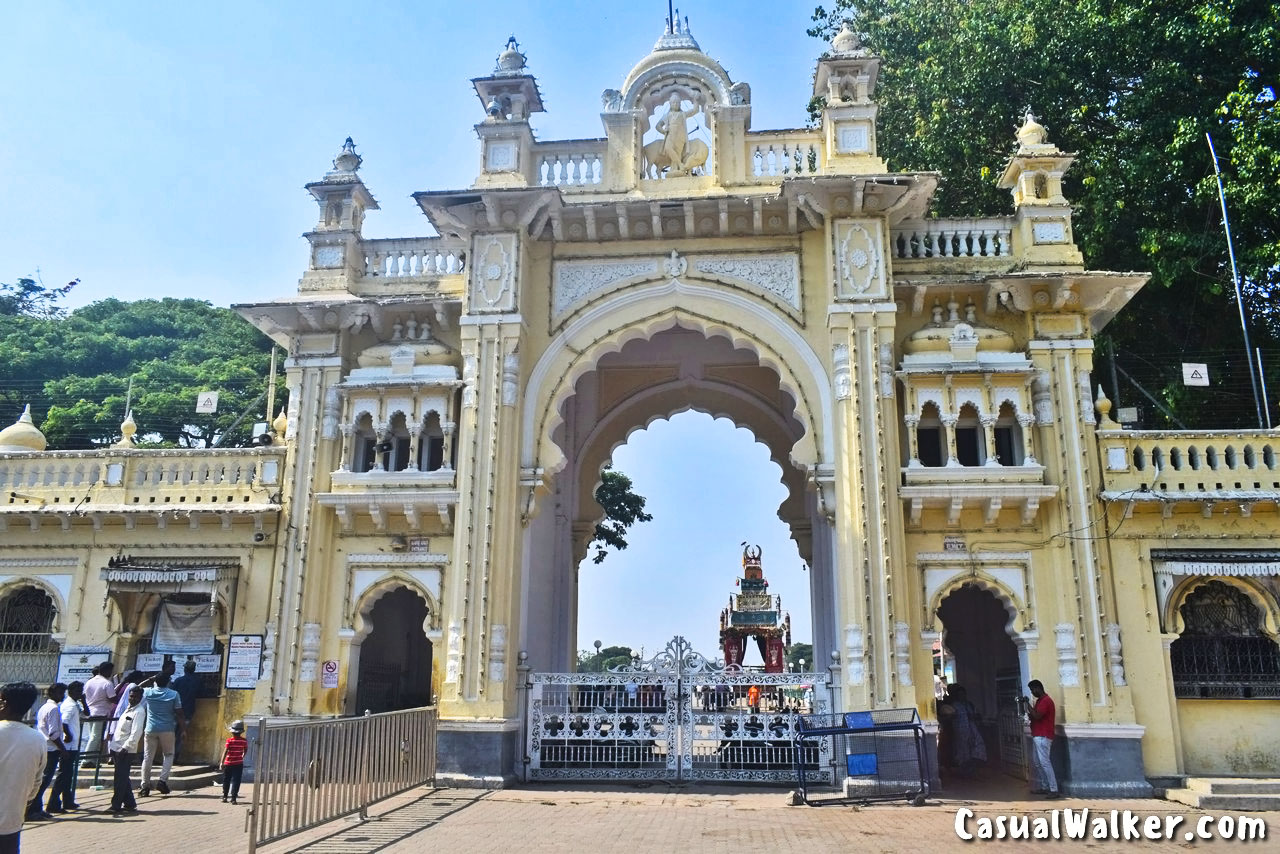
The Mysore Palace is one of the largest and most magnificent palaces of India, which tells the history of the Yatuvamsa kings of Mysore. The construction of the Mysore palace was started in 1897 and it was completed in 1912 after fifteen years of work process.
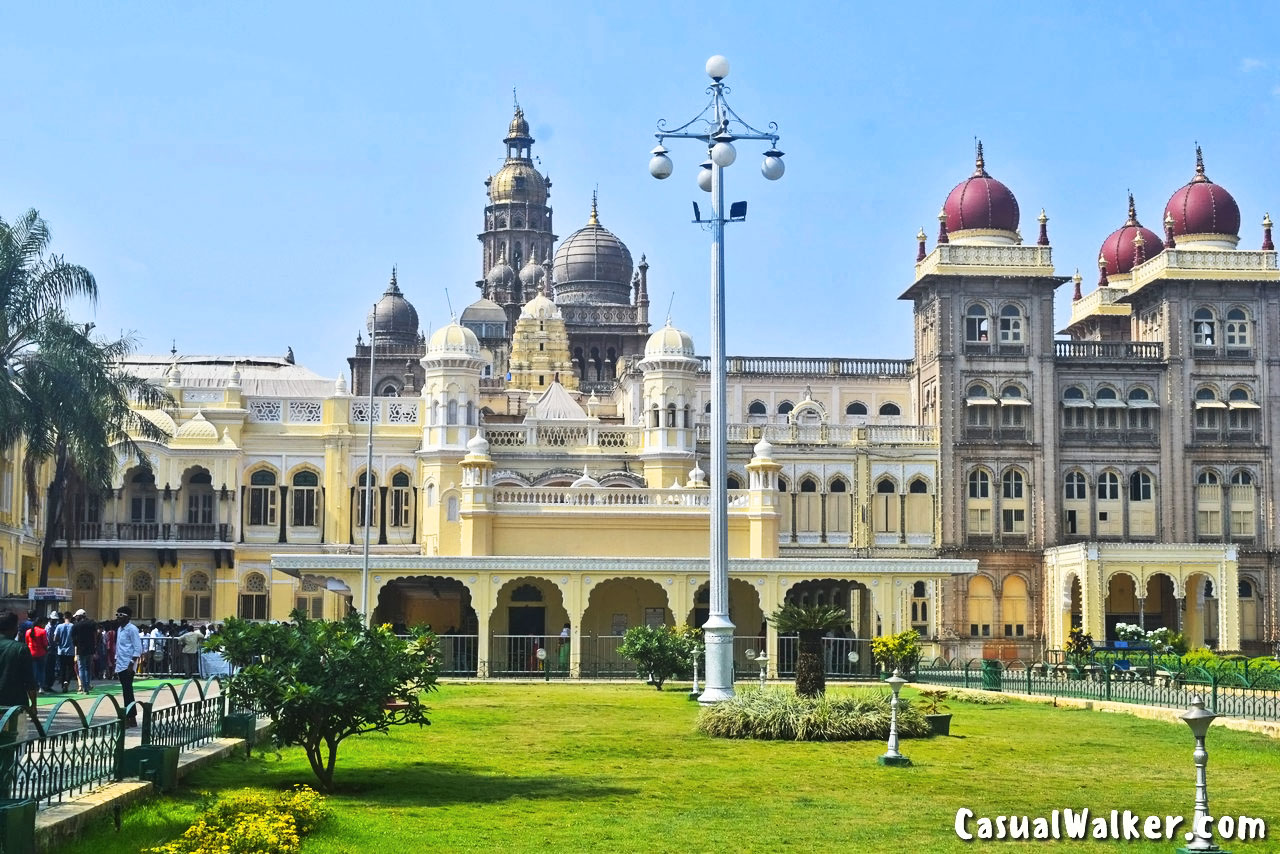
Queen Kemba Nanjamni Vanivilasa Sannithana was the person who supervised and supported the construction of this palace, which is an example of the glory of the Wodayar Kings dynasty. The forts that are the residence of the king are built as palaces to proclaim the artistic taste and the artistry of the royals.
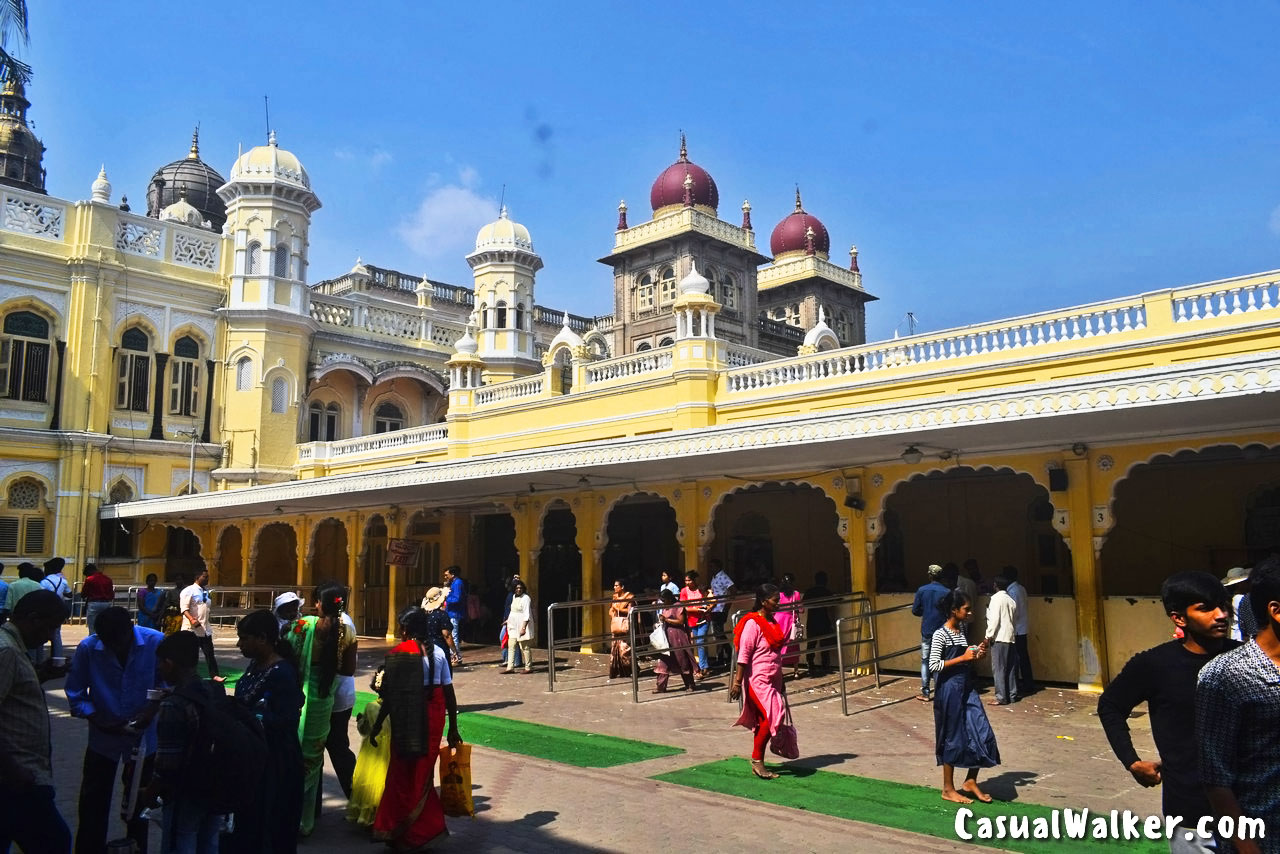
History of Mysore Palace / Amba Vilas Palace in Mysore
Mysore was initially ruled by the Yatuvamsa – the Wodayar family as a minor kingdom under the Great Vijayanagara Empire until 1565 and then after the fall of the Vijayanagara Empire many small kingdoms in South India attained independence, Mysore also became independent.
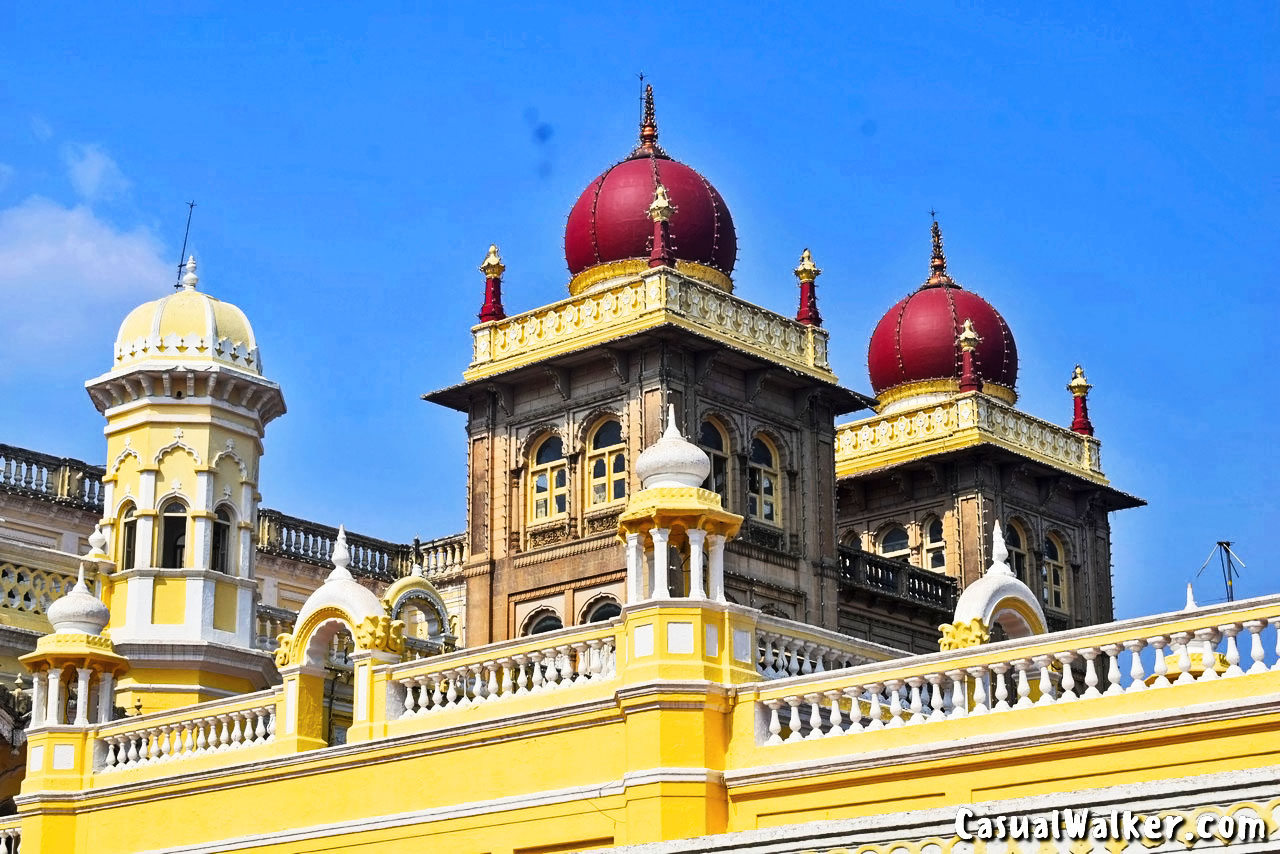
Under the kings Narasaraja Wodayar and Sikka Devaraya Wodayar, much of the present southern Karnataka state was brought under the Mysore Empire and a powerful empire was established in the Mysore region.
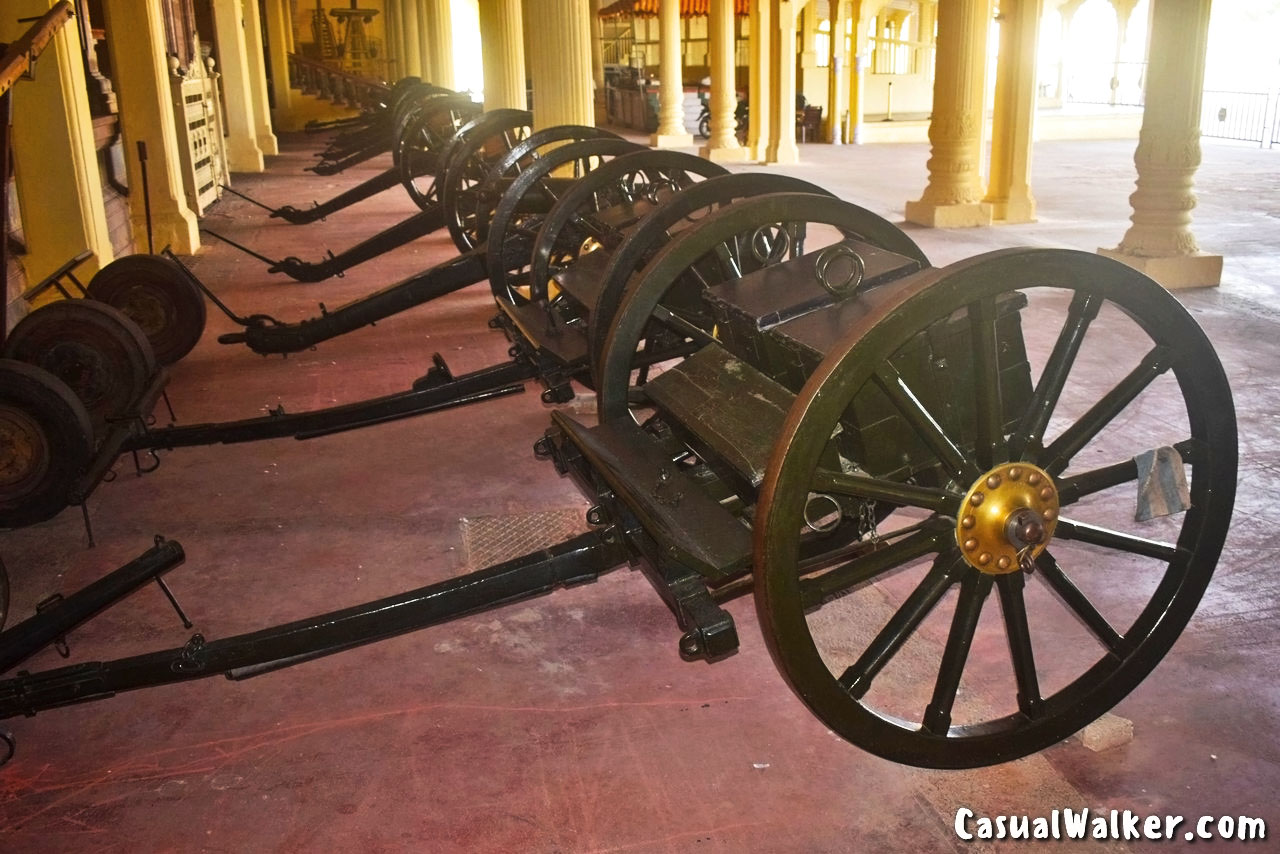
Devaraja Ammani, the daughter of Samaraja Wodiyar, who descended from the Wodiyar kings, married King Yathuraya and settled in Mysore. The Mysore Palace which was established during the reign of the Yathuraya kings, was significantly damaged in a devastating fire accident during the reign of Ranadeera Kandirava Nagaraja Wodiyar, so a new palace was rebuilt.
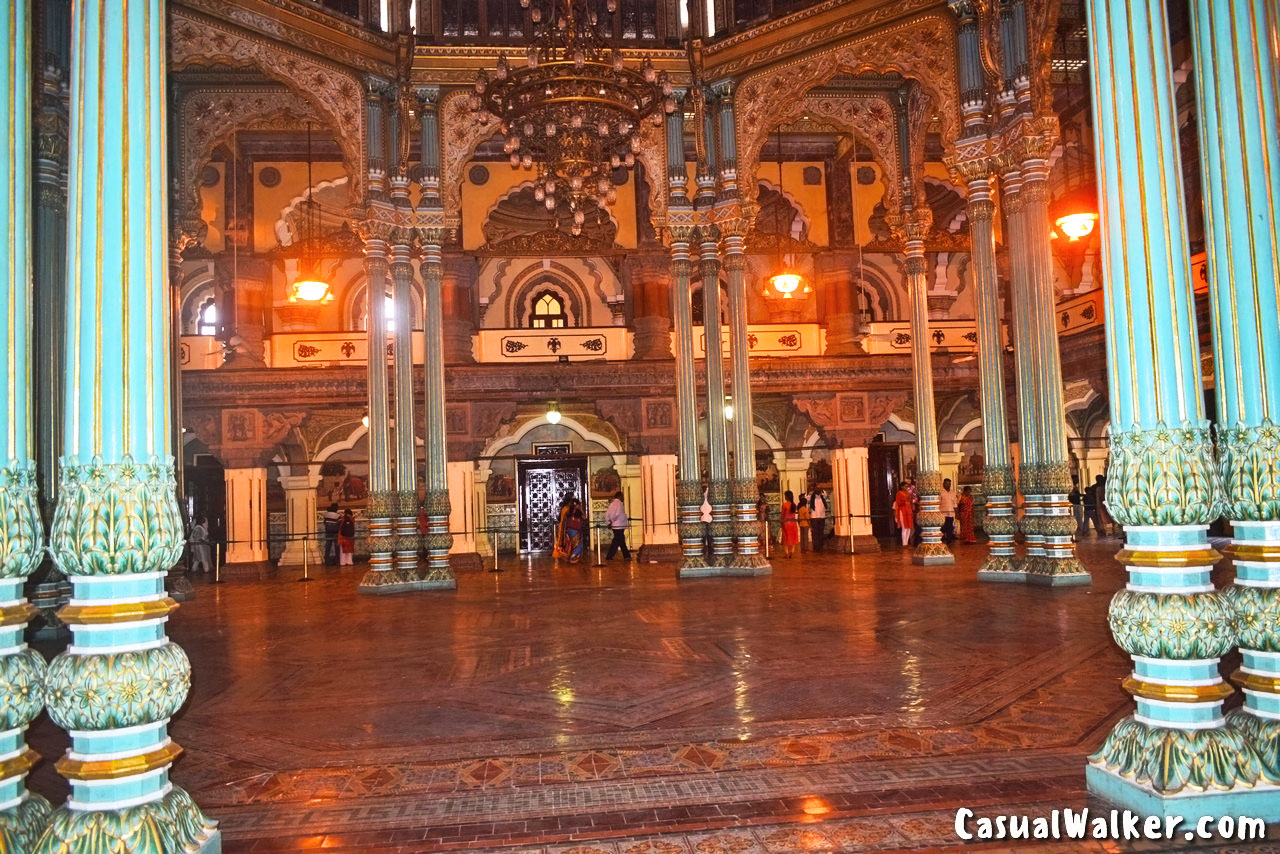
It has been mentioned in history that in 1760, Krishnaraja Wodeyar, who was the king, handed over this palace to Hyder Ali for maintenance. It is also said that after the death of Hyder Ali in 1793, Tipu Sultan, who defeated the kings of Mysore, ruled the region as Sultan.
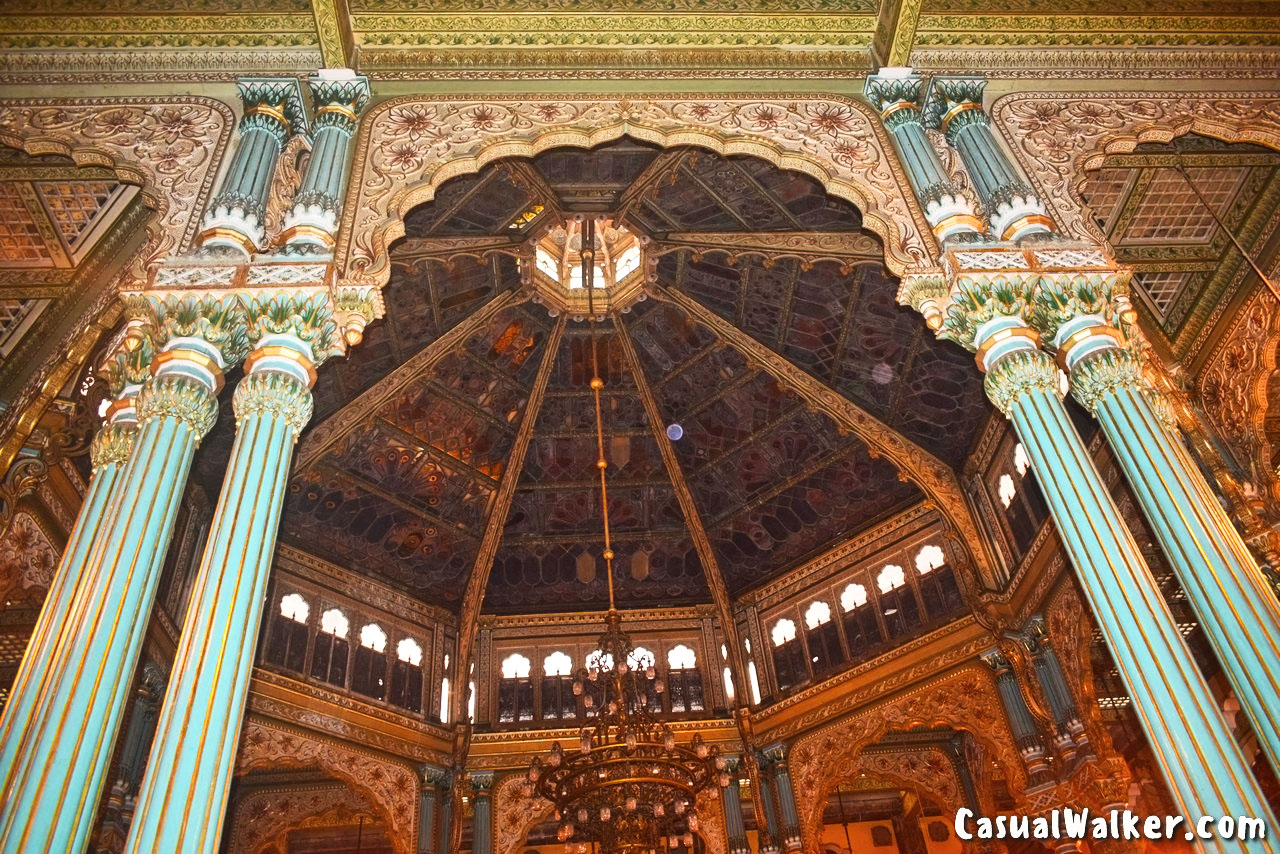
Colonel Wellesley, in a letter to his brother the Earl of Mornington on 14 June 1799, mentions that after the death of Tipu Sultan, the five-year-old Krishnaraja Wodayar was coronated as a King of Mysore near Nazarbad.
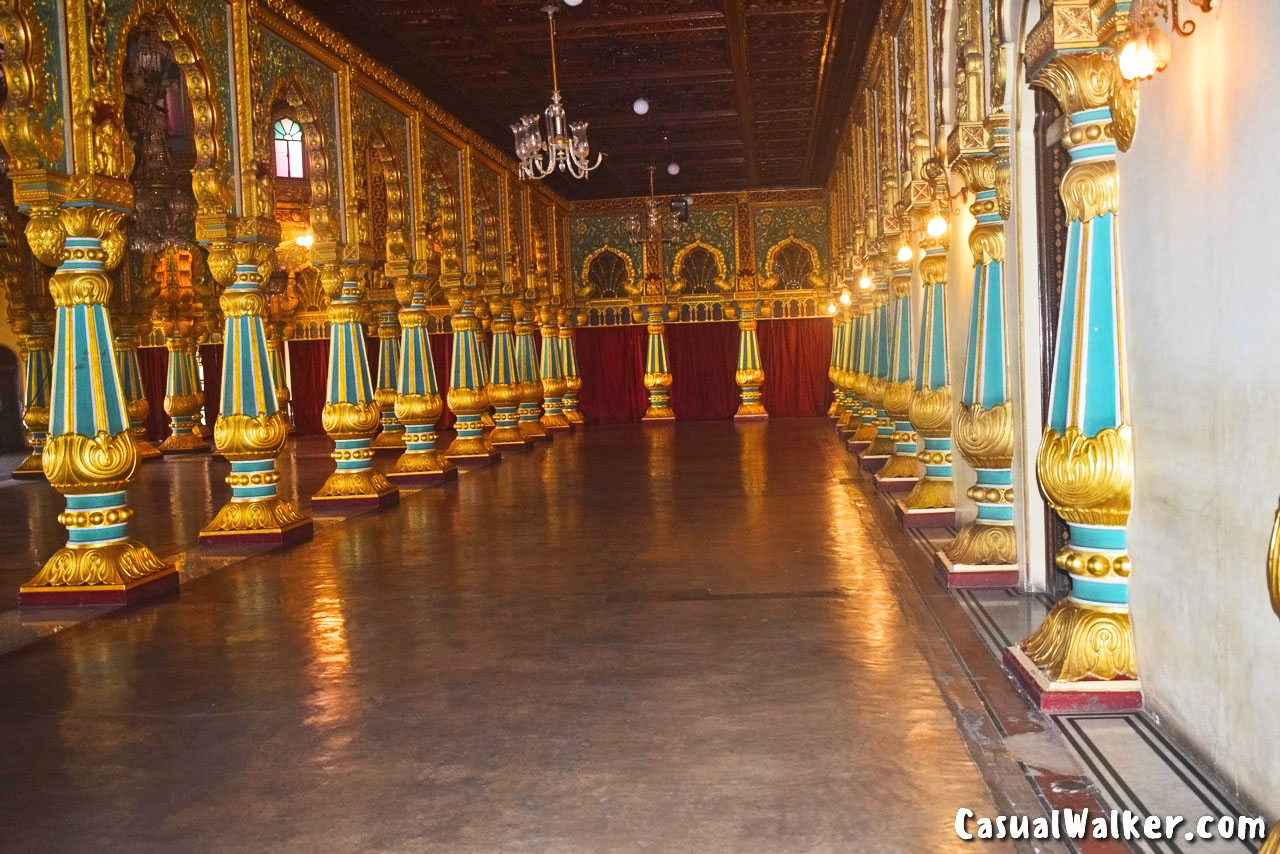
During the Dussehra festival of 1896, the old palace was gutted in a devastating fire. British architect Henry Irvine was commissioned by Maharaja Krishnaraja Wodayar IV and Maharani Kempananjammanni Devi to build this new palace. In 1912 saw the inauguration of ‘Amba Vilas Palace’.
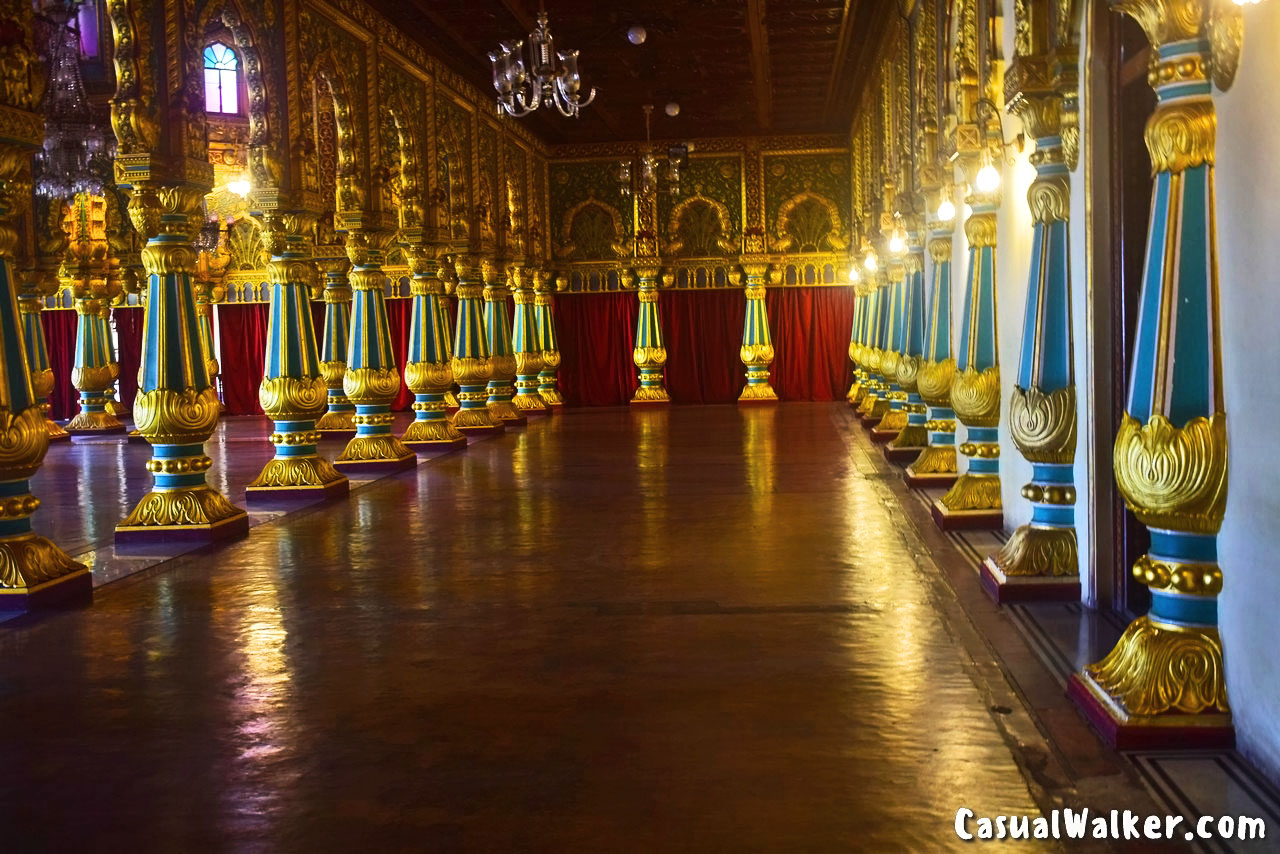
Because of the experience of previous palace fires, construction materials were used in such a way that the palace could not catch fire easily. Fire extinguishers were also installed.
During the reign of Maharaja Jayachamarajendra Wadiyar, the present public Durbar Hall was added in 1930 and the palace was further expanded. So the beauty of the present palace was doubled.
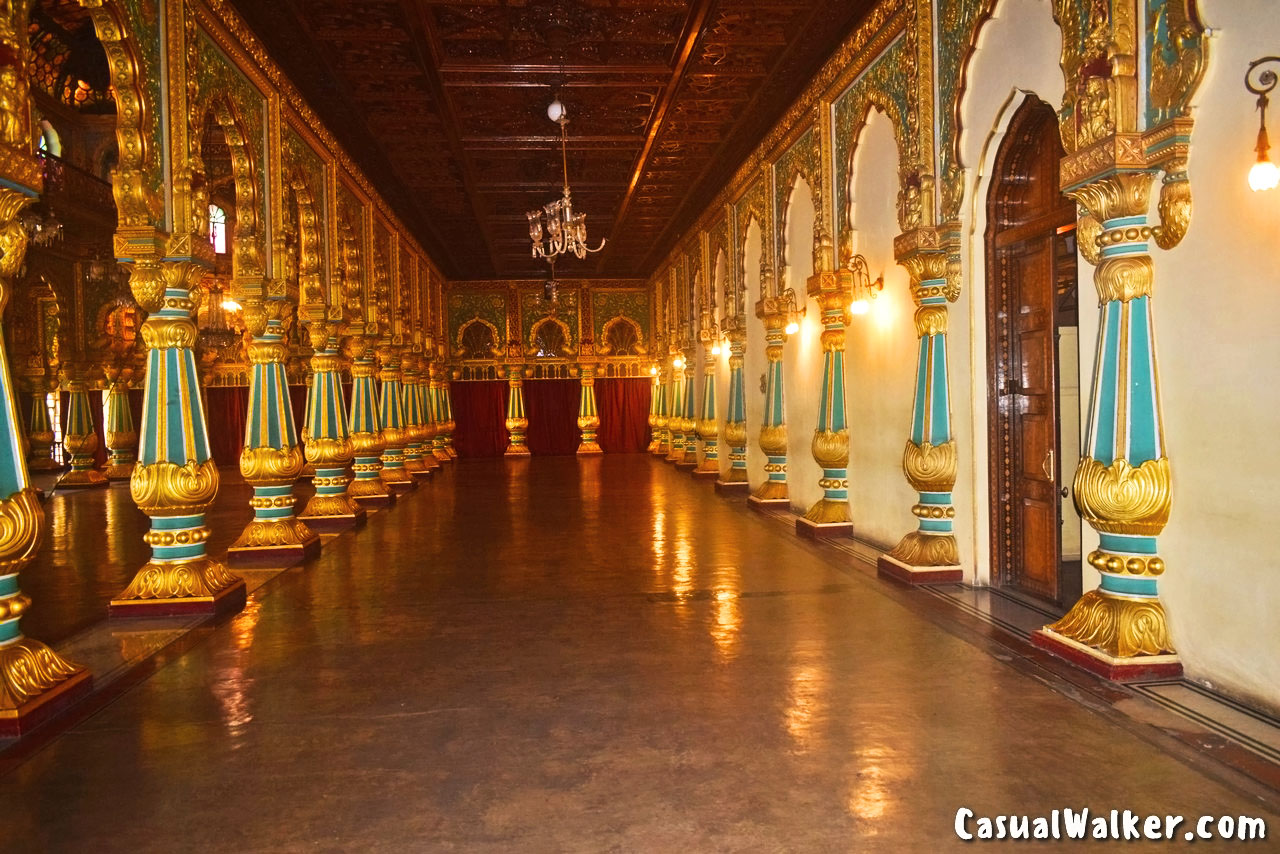
Mysore Palace / Amba Vilas Palace Architecture
The century-old Mysore Palace is 245 feet long, 150 feet wide, and 145 feet high and has a marble dome with a surrounding garden. The palace was designed to reflect Indo-Saracenic civilization and was based on Hoysala and Greek sculpture. A large amount of granite stones were used to build this three-storied palace. On the second floor of the palace, there is a hall where the wedding ceremony of the royal family takes place. We can find a bunch of Cannon at the entrance of the Mysore palace.
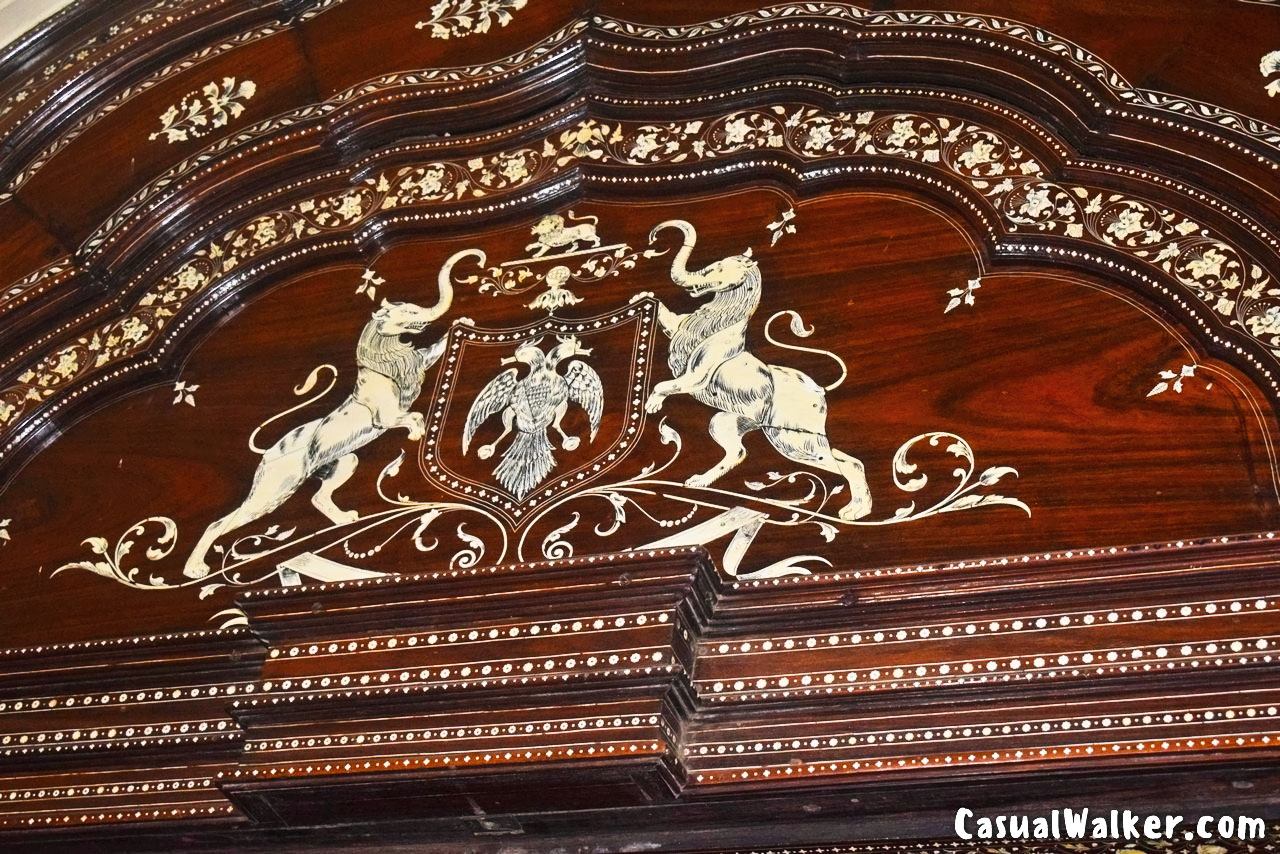
From here the Durbar Mandapam has been erected in a straight line so that the King can have darshan of Goddess Chamundeeswari on Chamundi Hill. The palace faces Chamundi Hill as the kings were devotees of Goddess Chamundi. The grand entrance gate, open-air halls, attics, towers, armory, library, elevator facility, hunting room, and private bedrooms are all located on the third floor of the palace. Adjacent to the palace is a 44.2 meter high five-storied pillared tower. The decorative urns on top of it are made of gold.
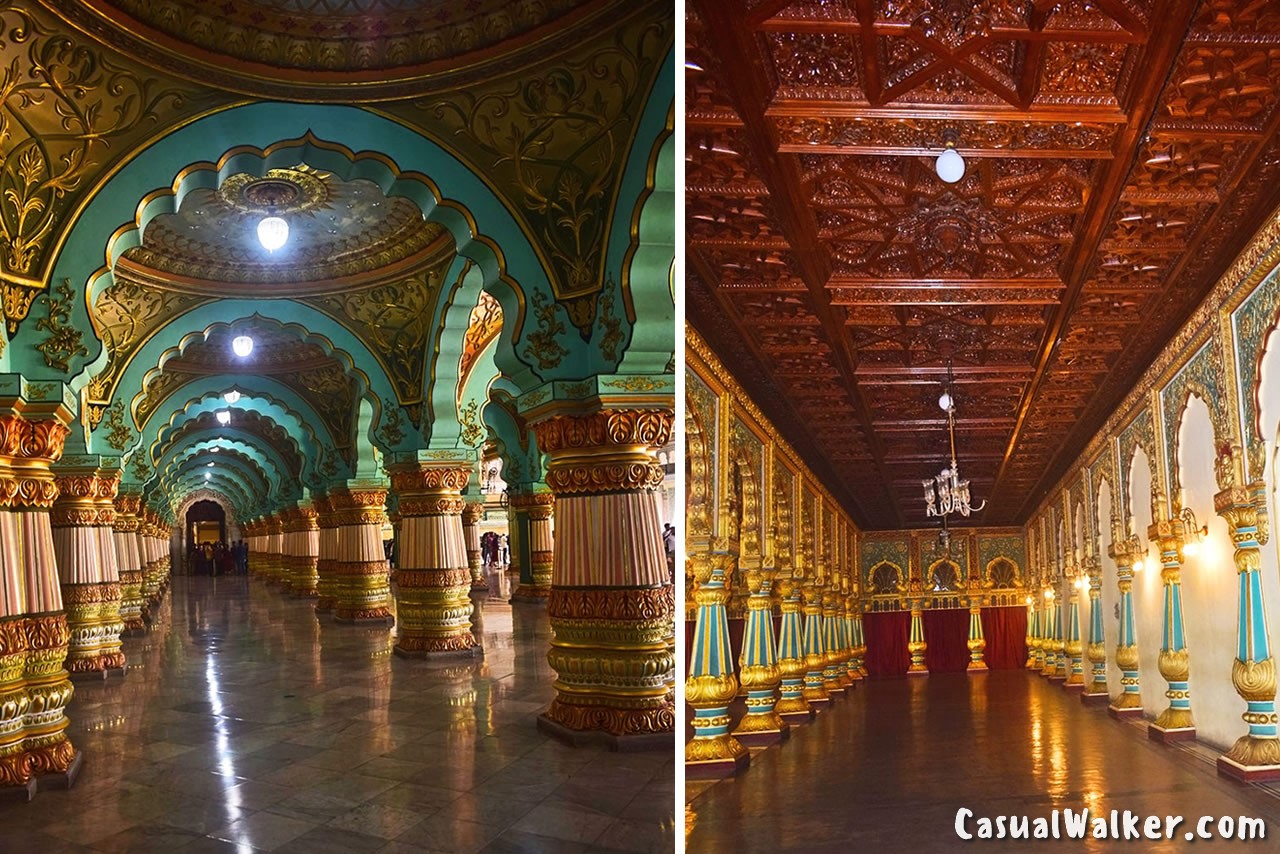
A wedding hall, two durbar halls, a music stage, a puppet exhibition room, a private room for the king’s diamond-encrusted bell crown, and temples are all here. The palace is full of intricately designed pillars, sculptures, and screens. Although the palace was built using local materials, granite was also sourced from Jaipur and Italy.
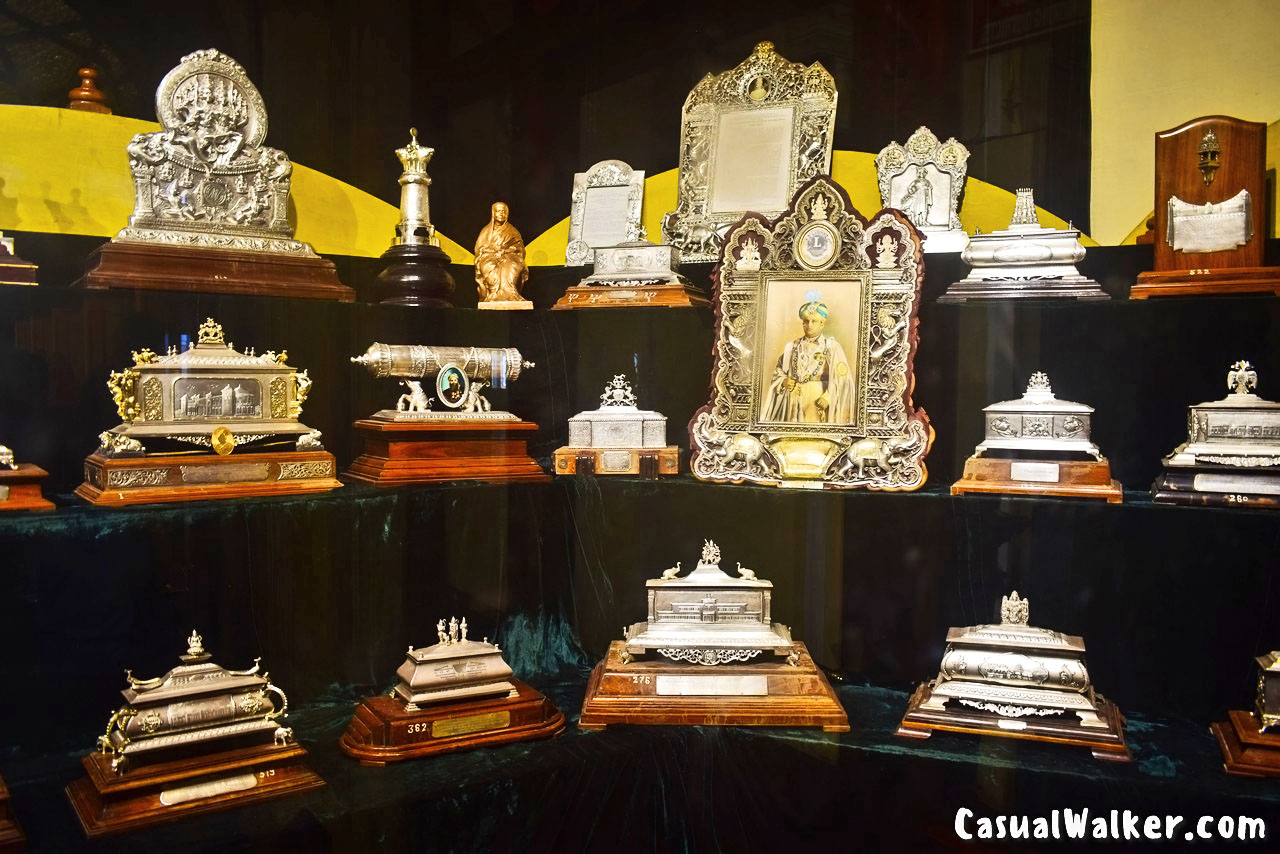
The main entrance gate bears the coat of arms and emblem of the Kingdom of Mysore. Above the central arch is a sculpture of Gajalakshmi, the goddess of wealth, fortune, prosperity, and prosperity, with elephants.
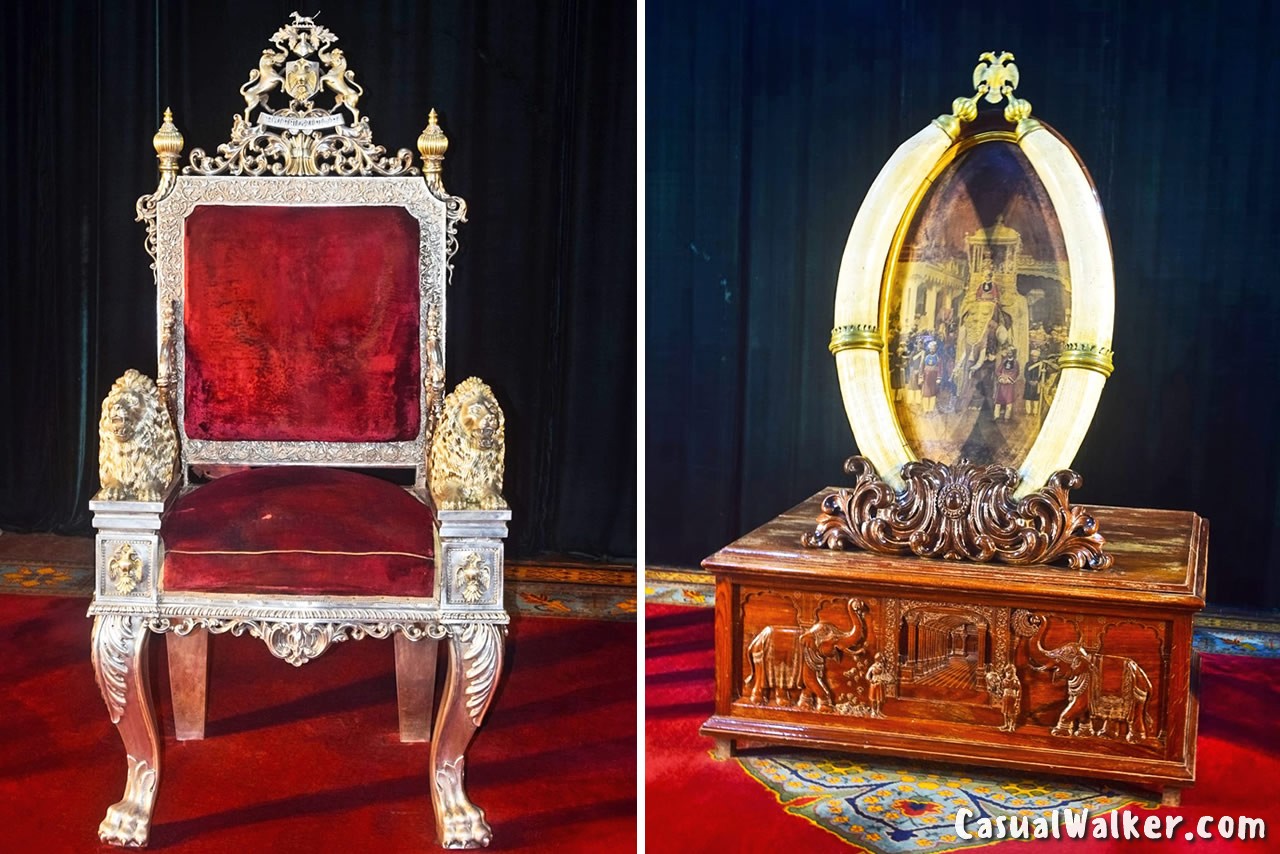
Mysore Maharaja’s Memorabilia at Mysore Palace / Amba Vilas Palace in Mysore
Mysore Palace showcased the paintings, memorabilia, royal costumes, and jewelry of the Wodiyar dynasty. The elephant gate with its royal emblem of Mysore – the double-headed eagle is the main entrance to the palace center. The royal elephant throne is situated to its north, inlaid with 84 kilograms of gold – 24 carats.
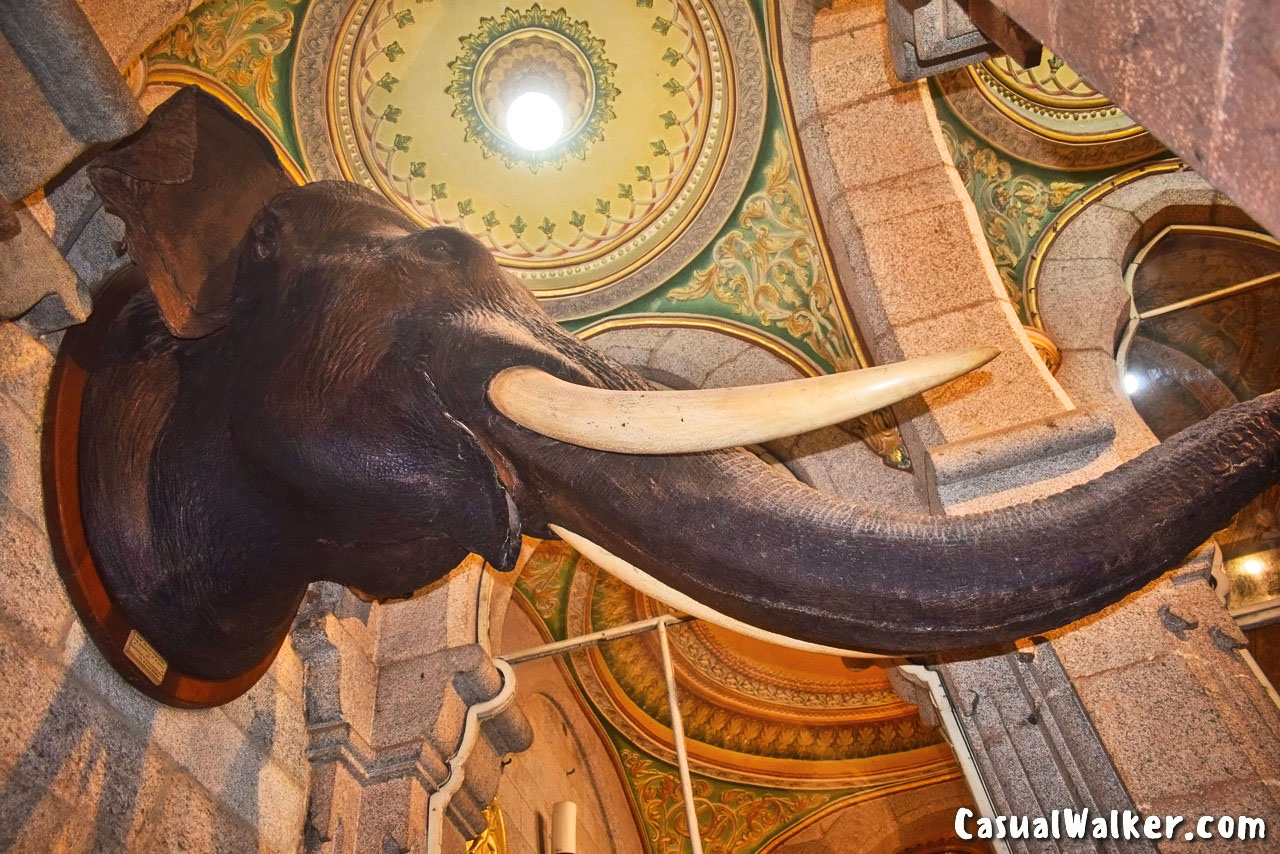
The golden royal elephant throne, kalyana mandapam marriage hall, and durbar hall are the main attractions. At the palace, we can find beautiful oil paintings adorning the walls leading up to the wedding hall. The novel feature of these paintings is that whenever they are seen the procession seems to be moving in the same direction.
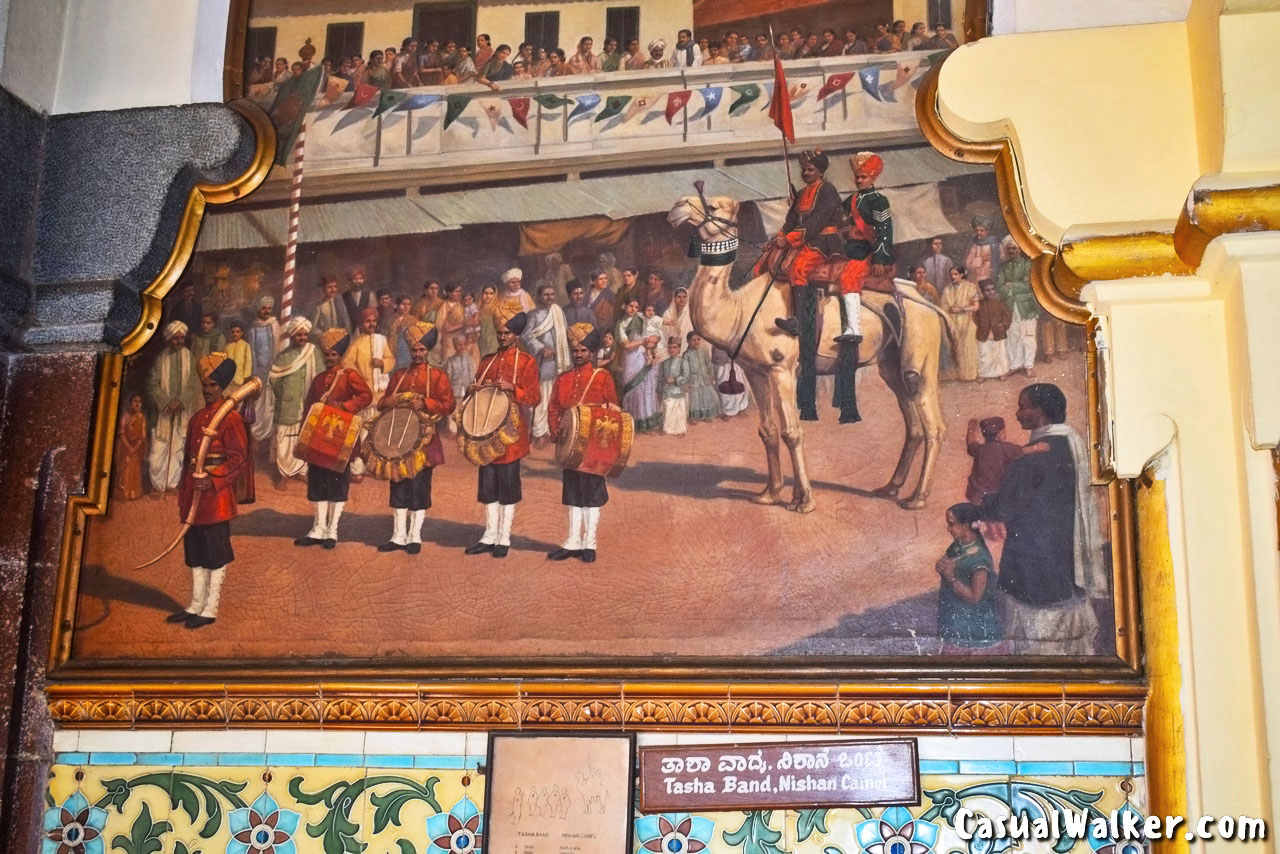
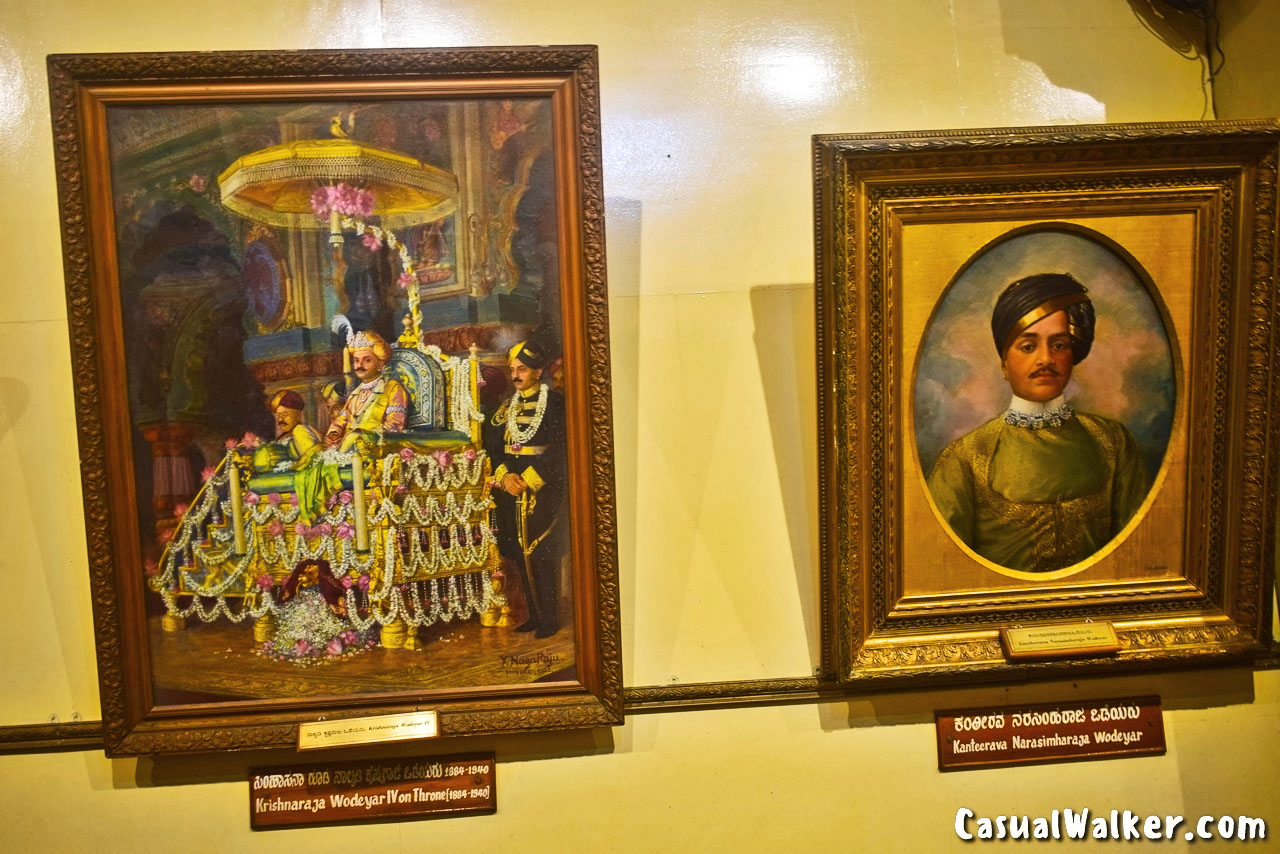
The hall has huge chandeliers, multi-colored glass, and peacock designs. The Durbar Hall has gold-painted pillars and ceilings and rare paintings by iconic artists. The world-famous Thanjavur paintings, Raja Ravi Varma’s paintings are also showcased.
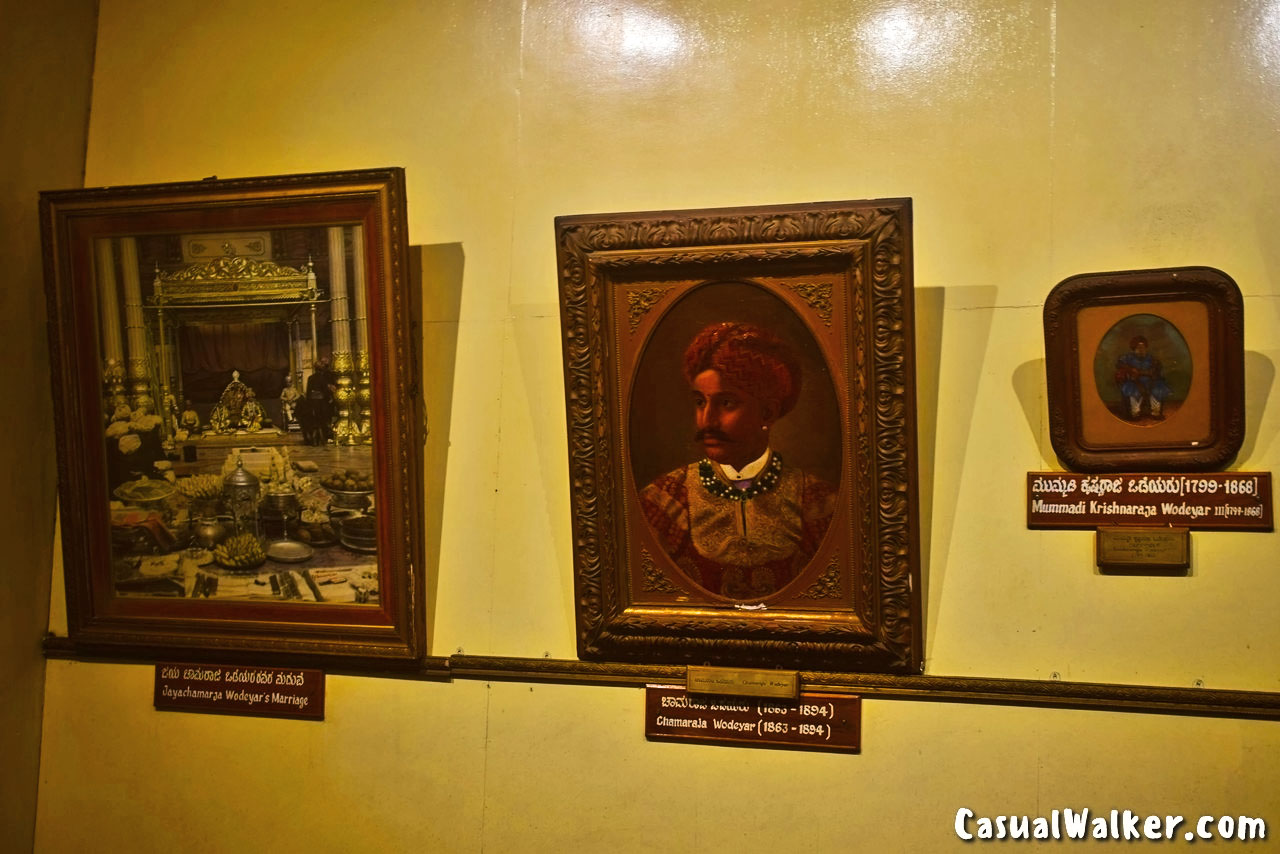
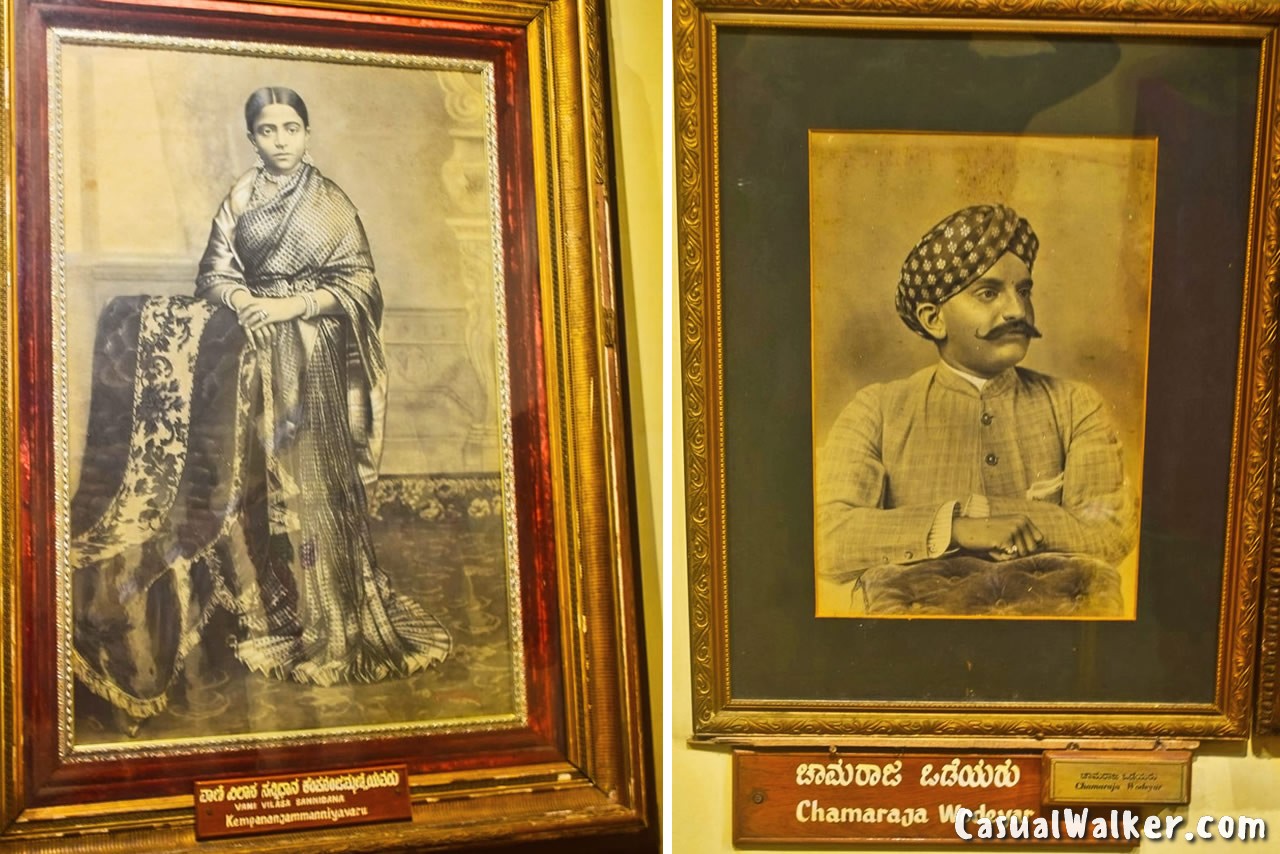
The history of the 25 successors of the reign of Emperor Wodiyar is all depicted in paintings in the palace complex. This mandapam houses a temple dedicated to Goddess Chamundeeswari and offers a magnificent view of the Chamundi Hills. It is also known that there are several secret tunnels that pass beneath the palace, including a cellar leading to the summer palace of Tipu Sultan, Srirangapatnam, and other palaces.
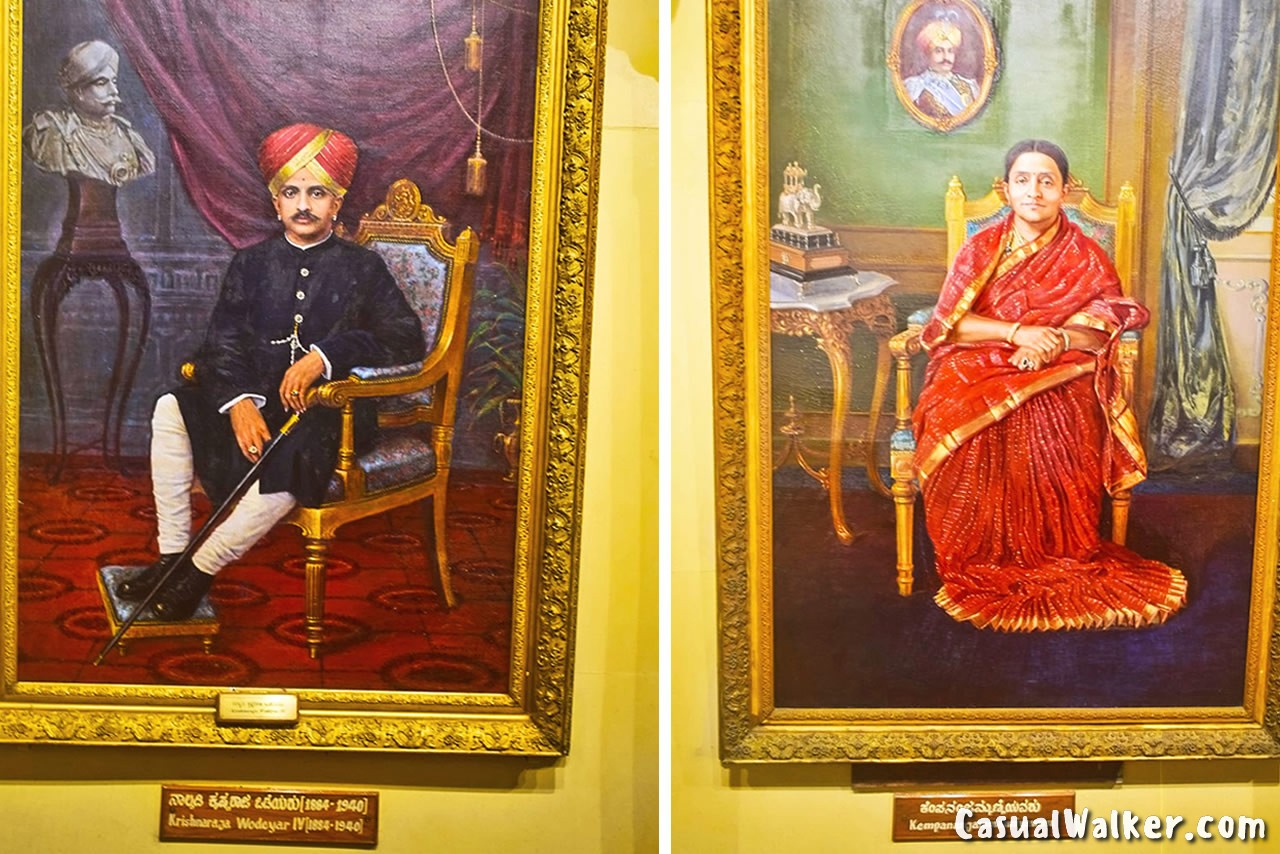
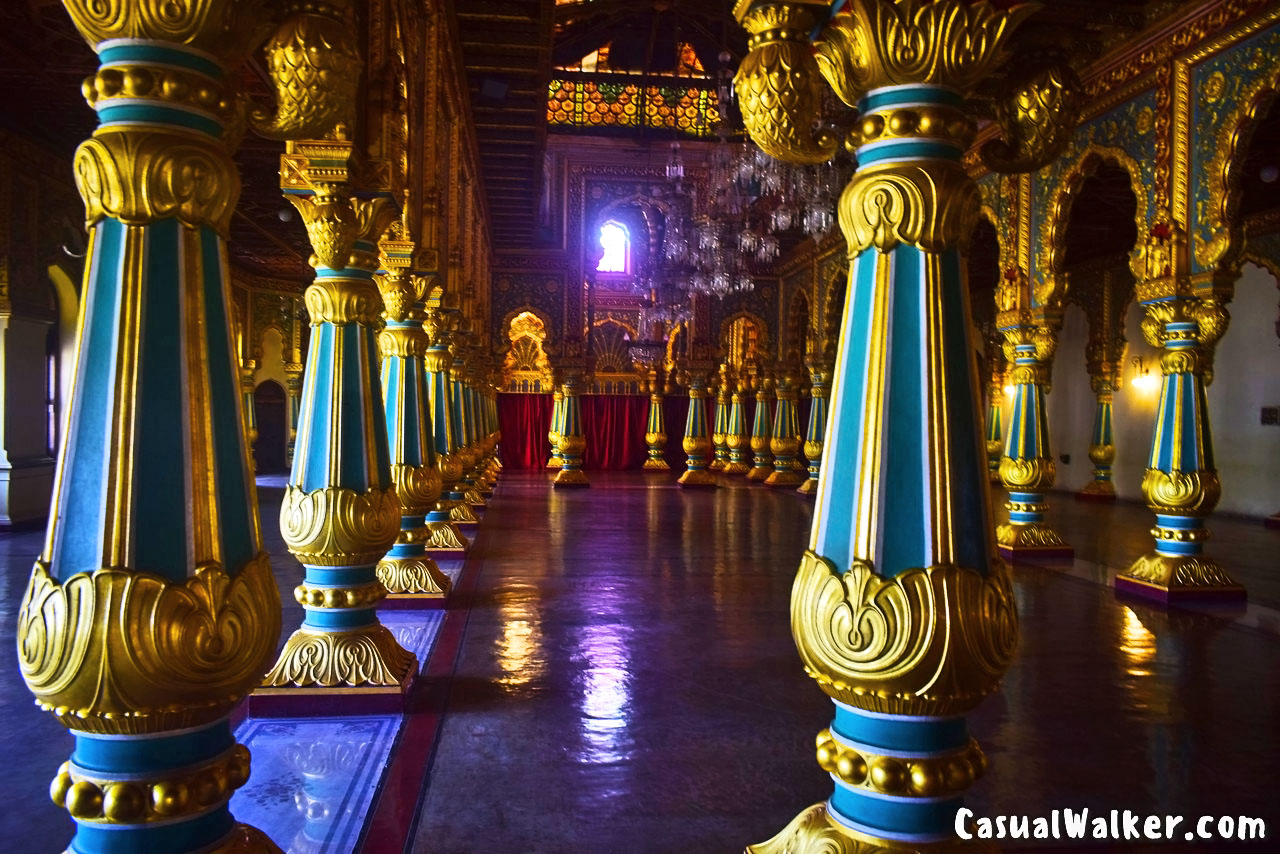
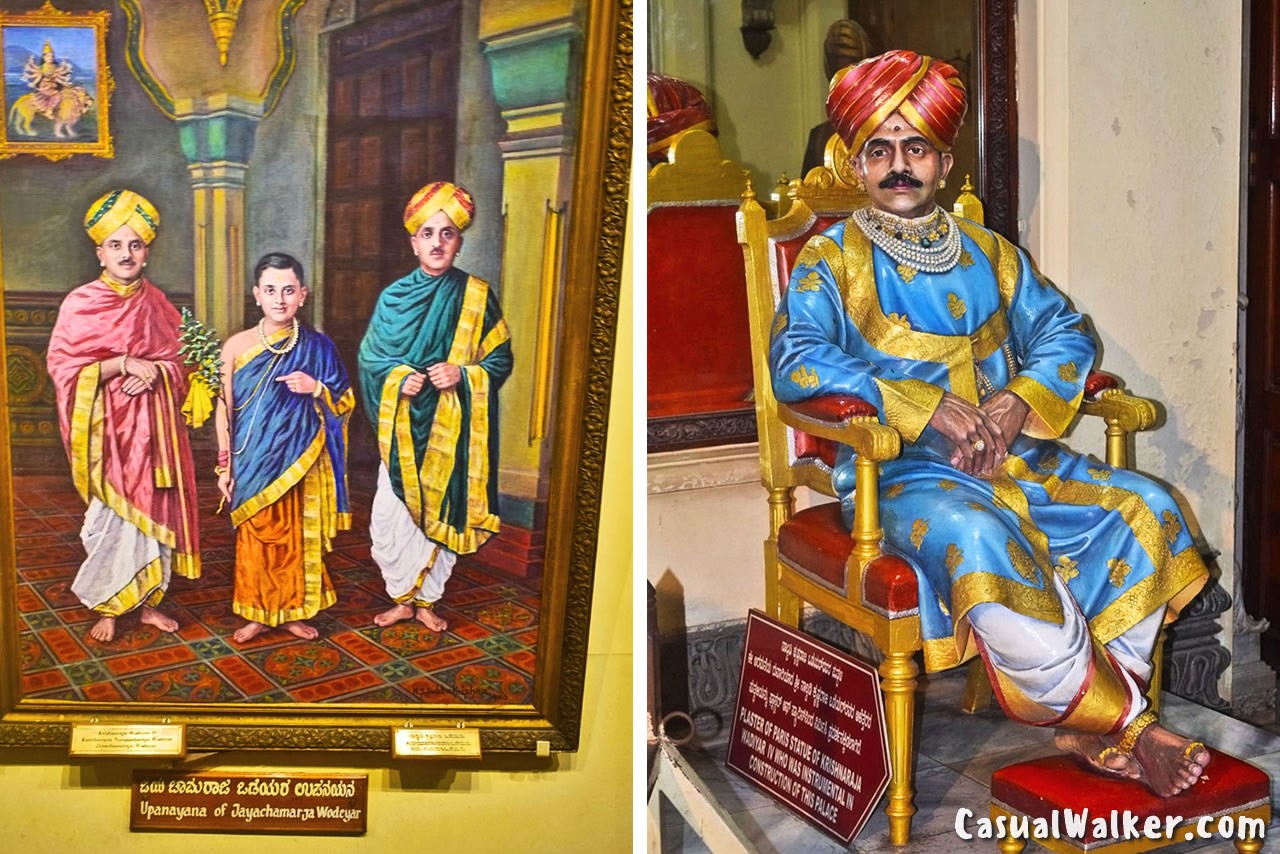
After India’s independence, the palace became state property. There are around 97,000 lights were placed around the palace building to brighten up the palace, which glitters like gold in the light of the lamp.
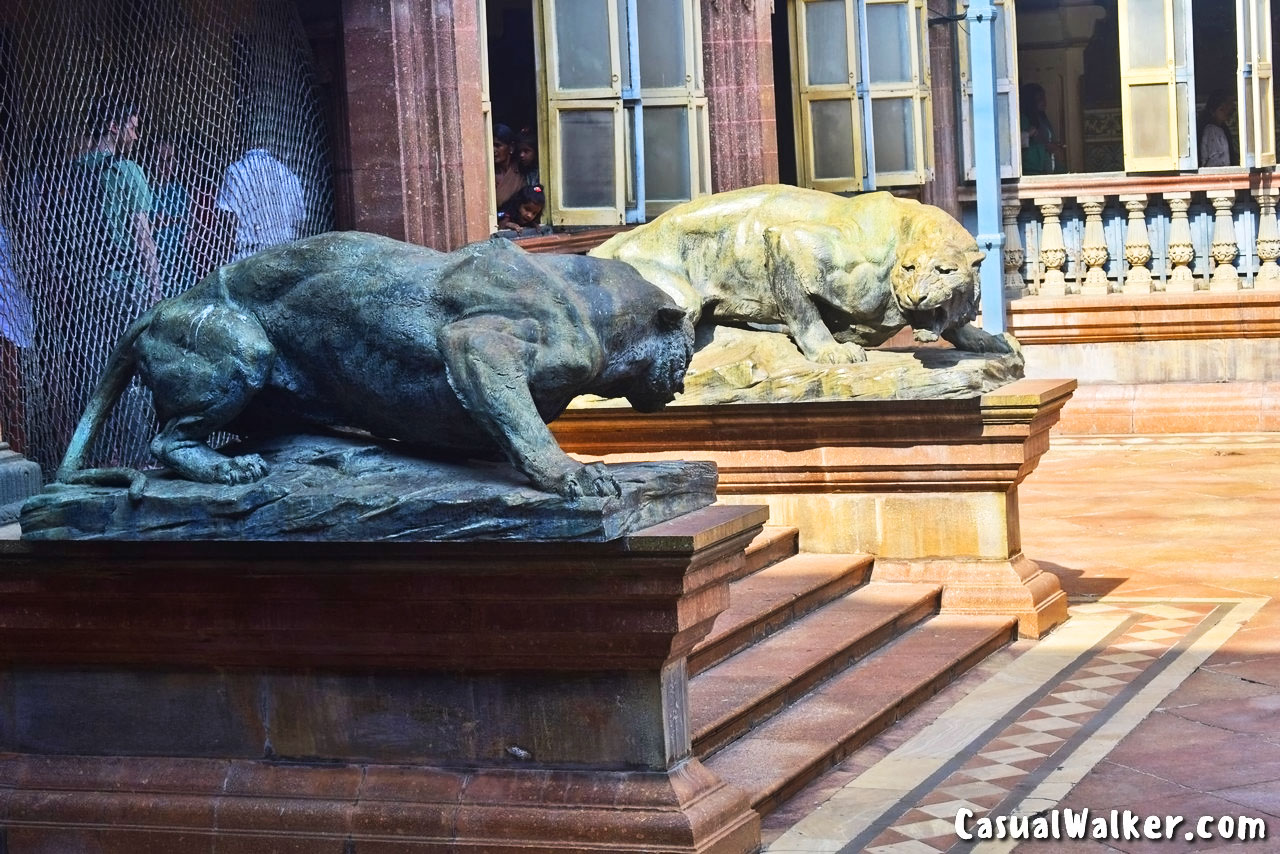
The intricacies of doors, windows, and decorative glass cabinets designed by woodworkers in the age of technological advancement still fascinate visitors. Tourists can enter this palace through a gate called Gombe Tank or Toy Canopy. Millions of visitors come here every year to see this majestic architectural wonder.
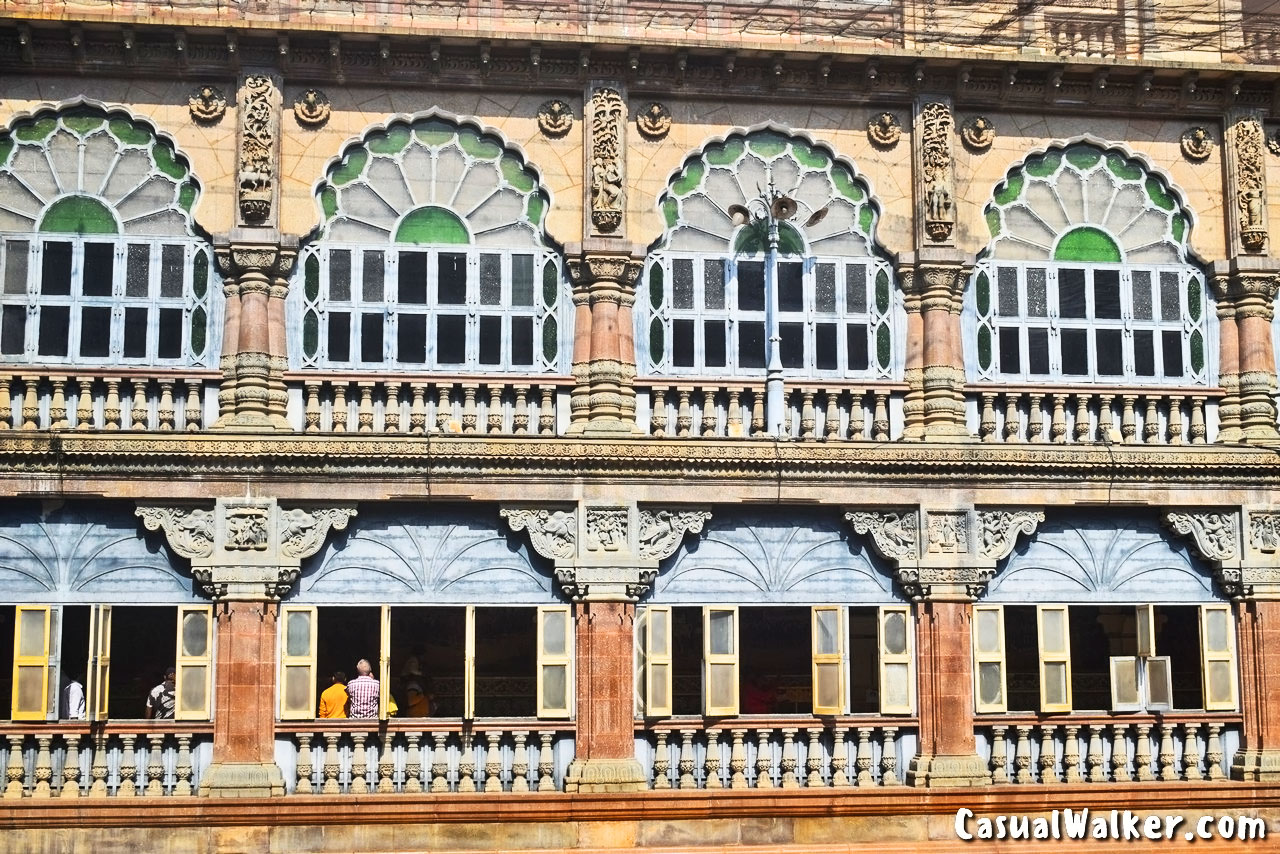
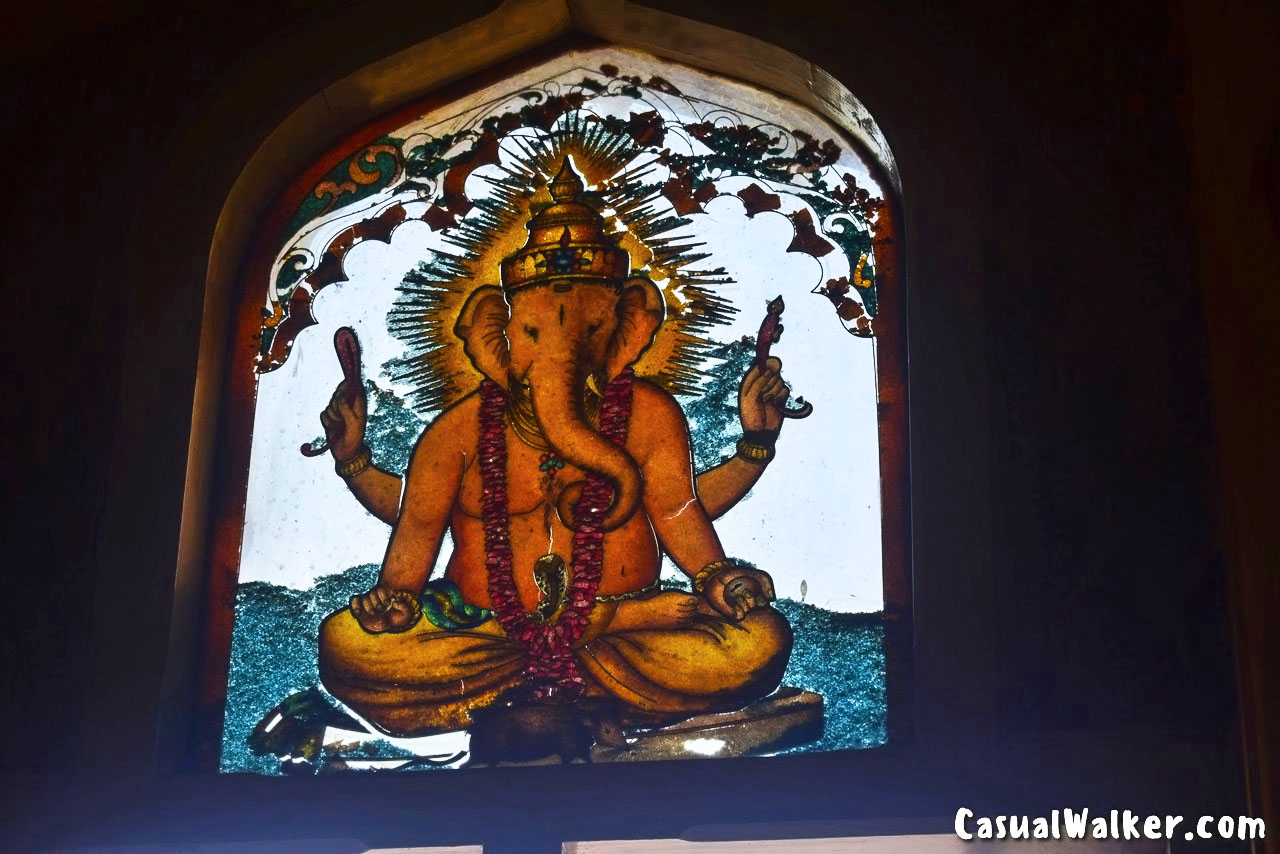
Mysore Dasara / Navratri 10 days Festival
The Mysore Palace comes alive, vibrant, and colorful every year during the world-famous 10 days of Dussehra celebrations / Navrathri festivals. During the festival, the palace is illuminated with one lakh colorful lights.
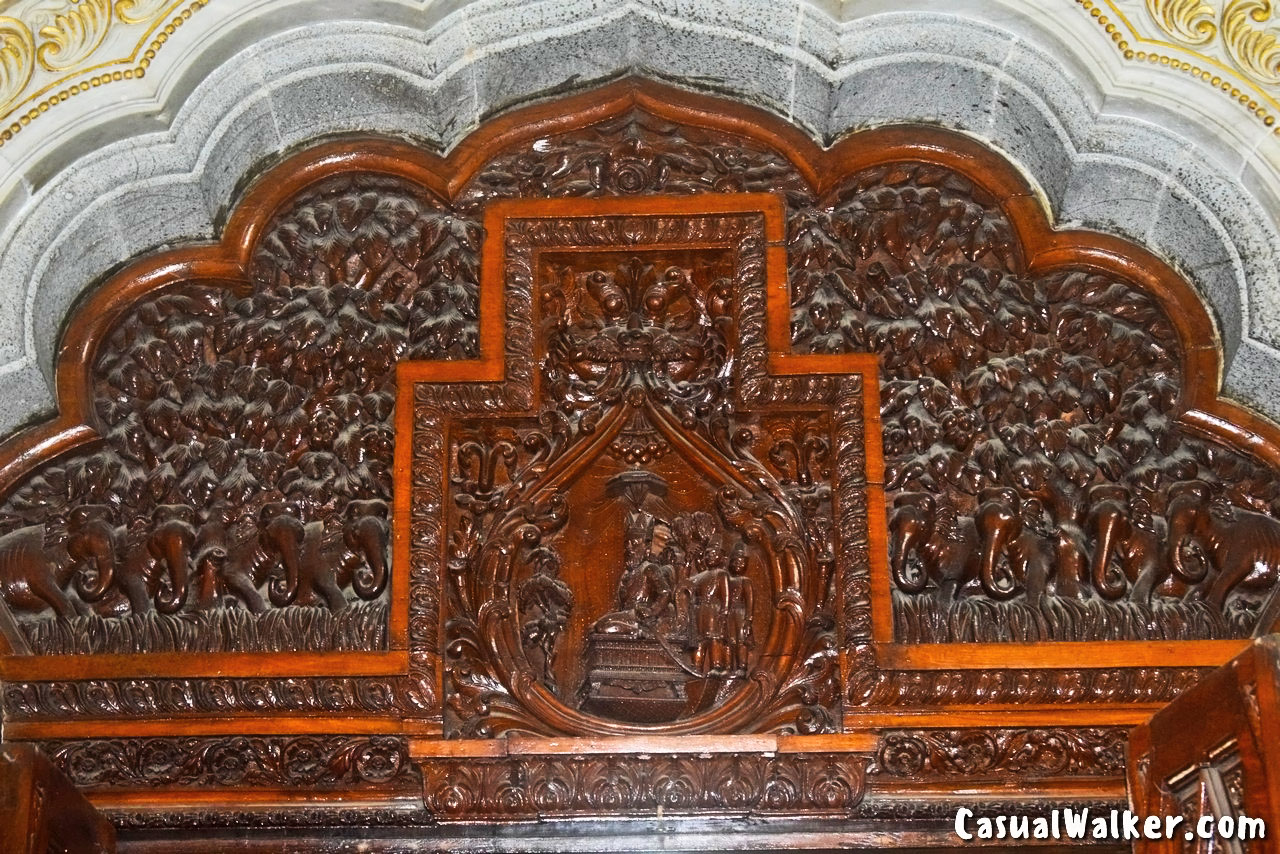
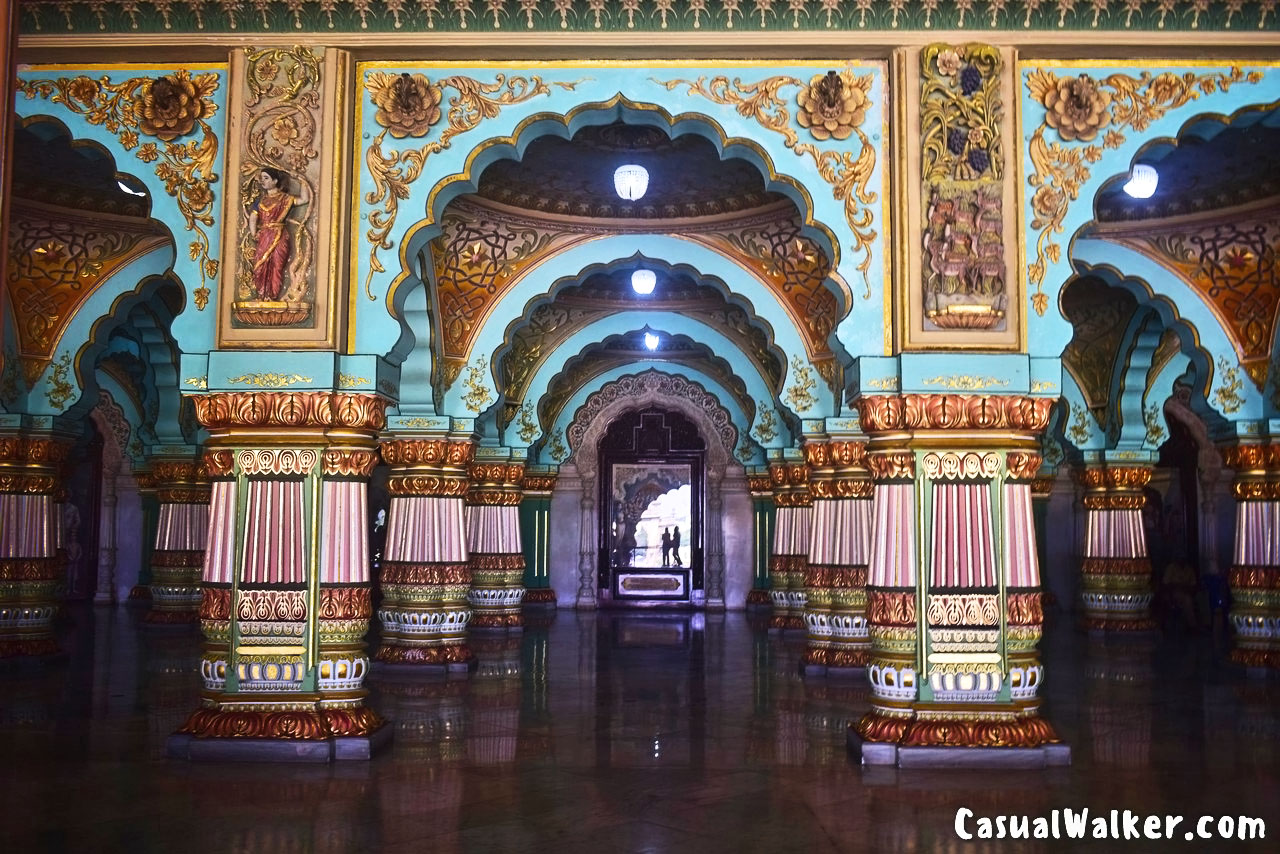
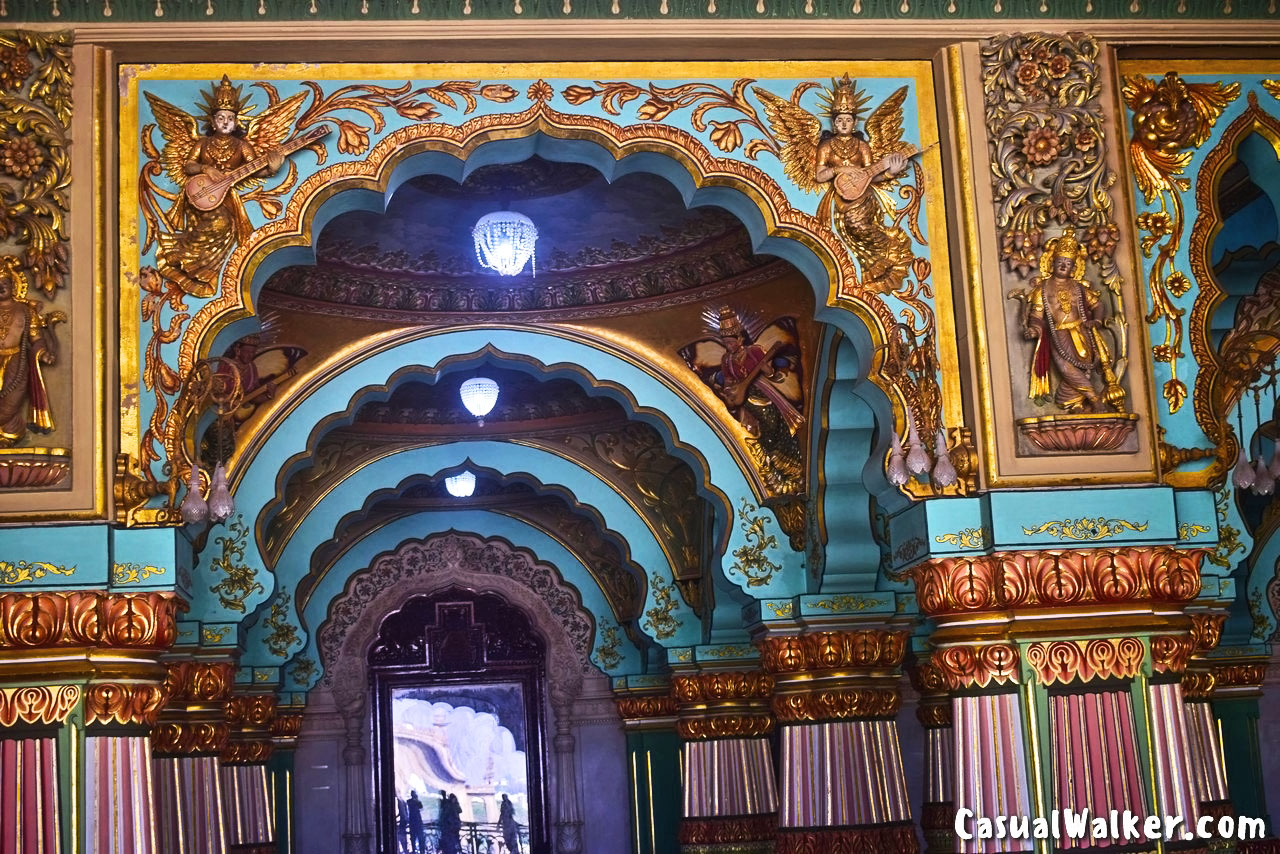
Light and Sound Show at Mysore Palace / Amba Vilas Palace in Mysore
A light and sound show is held every evening for 45 minutes on all days except public holidays and Sundays, depicting the 400-year history of Mysuru. Also, an 15 Minutes Palace Illumination can be seen at the end of the Sound and Light Program Show.
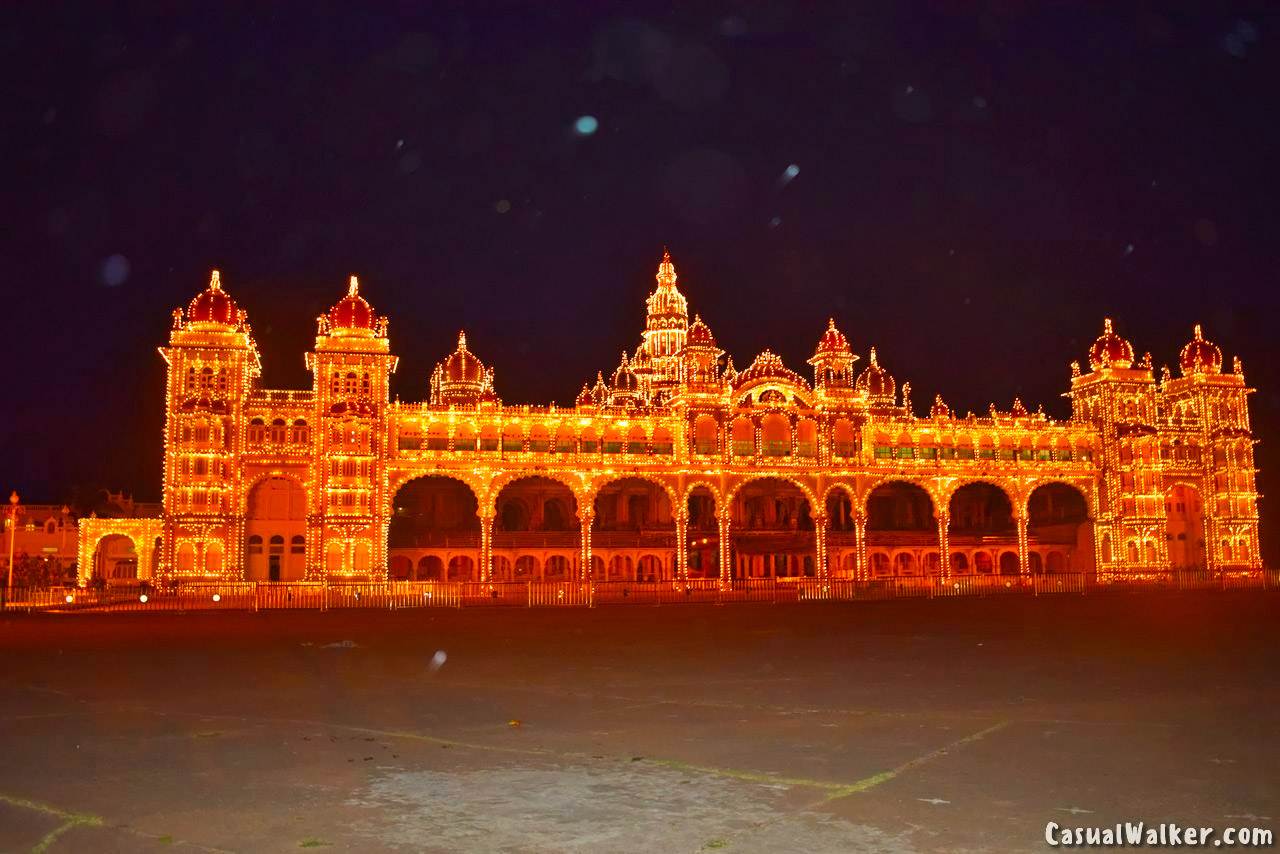
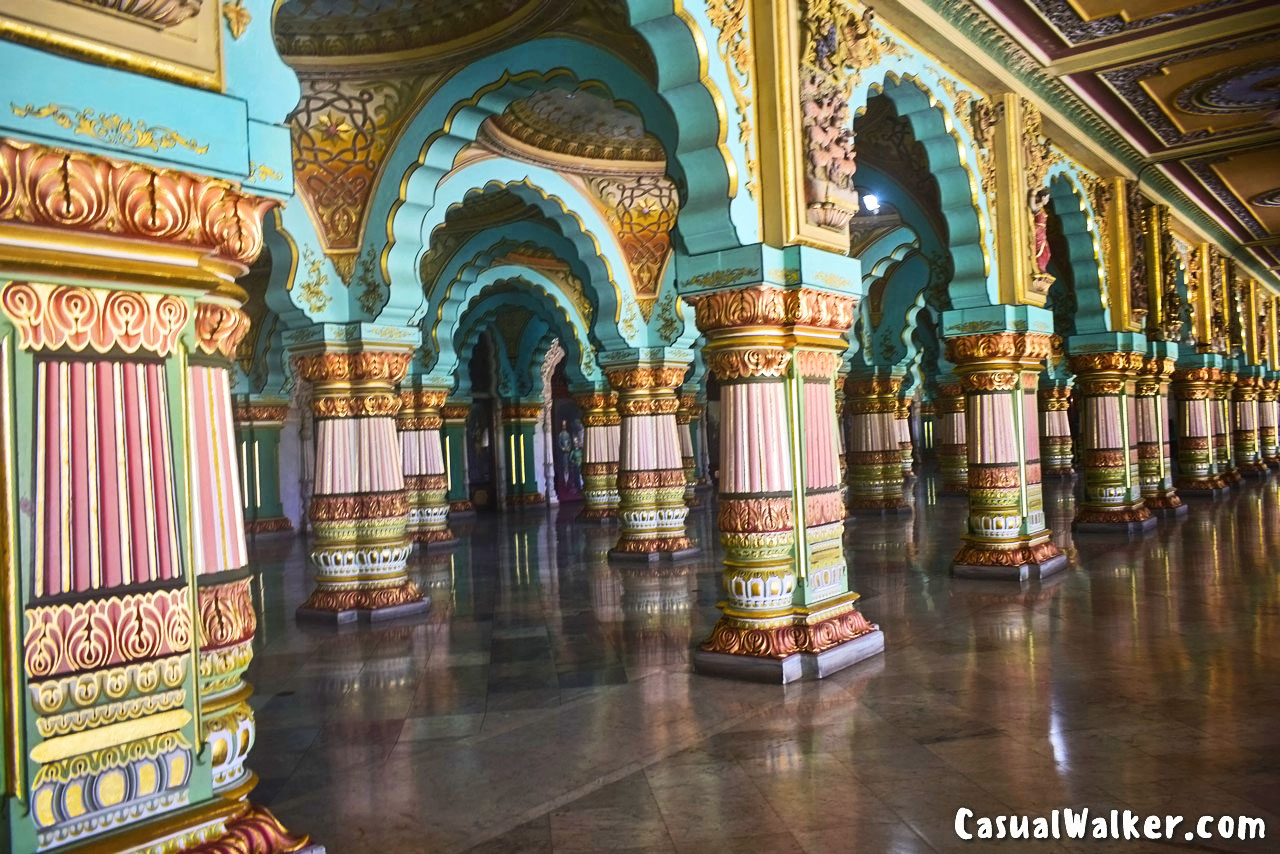
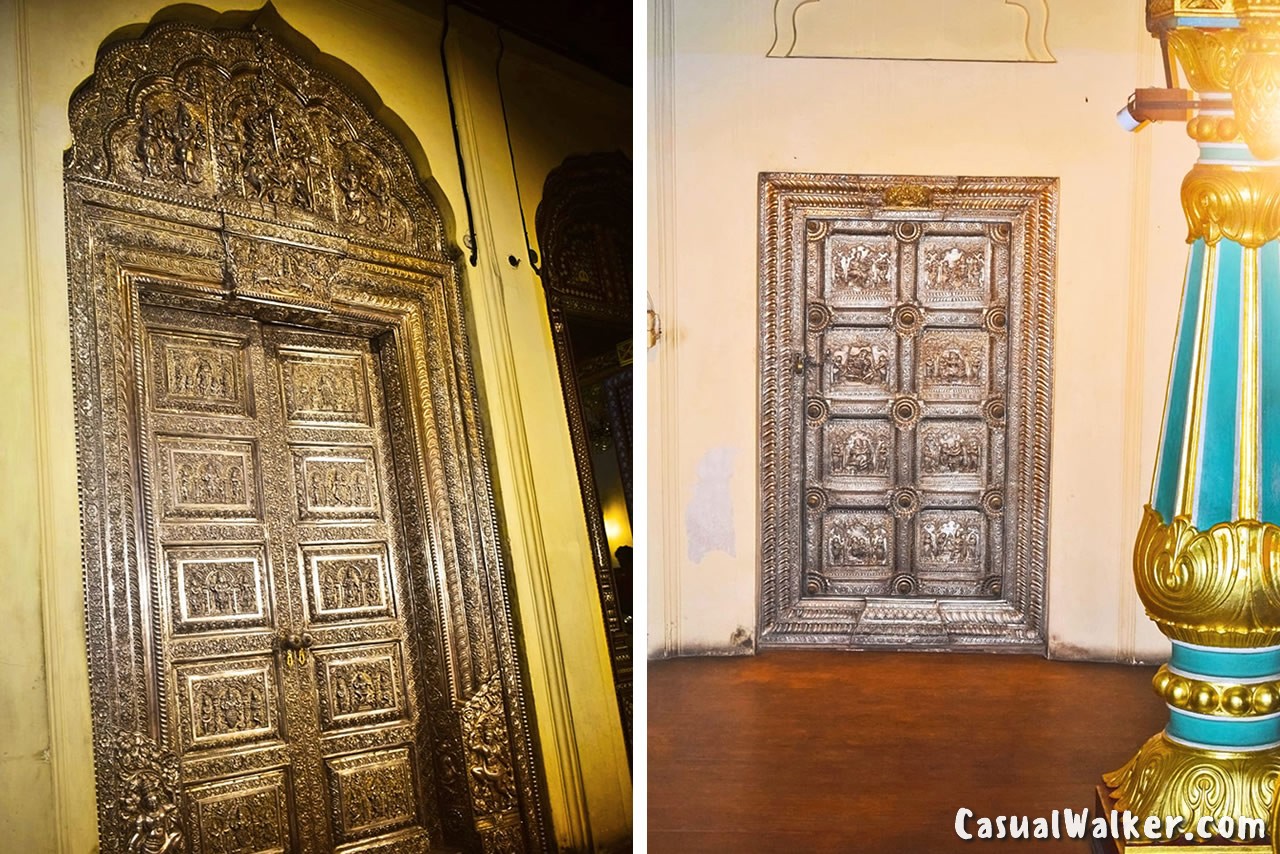
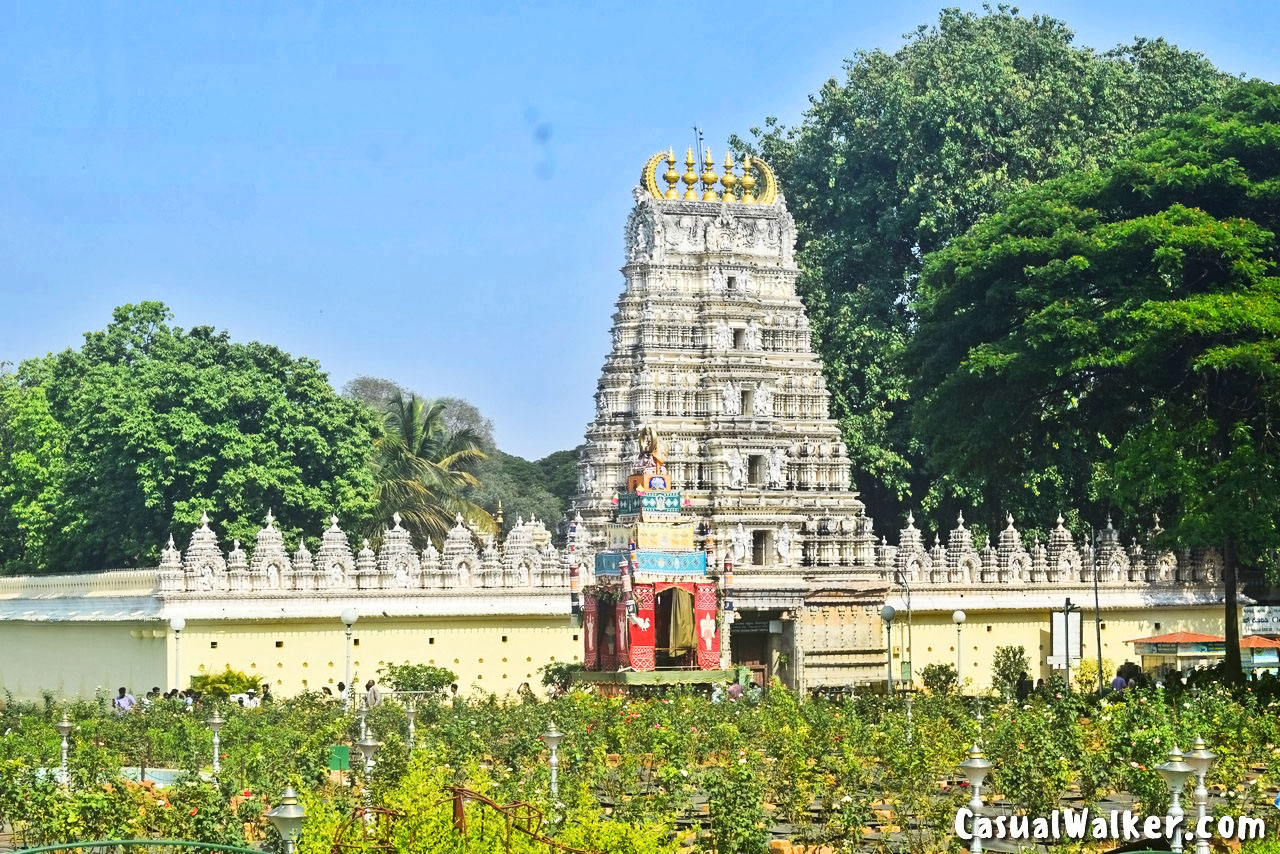
Temples at Mysore Palace / Amba Vilas Palace in Mysore
There are three temples inside the old fort complex and 18 buildings within the building in the center of the palace. Shree Shvetha Varaha Swamy Temple is the largest temple inside the palace.
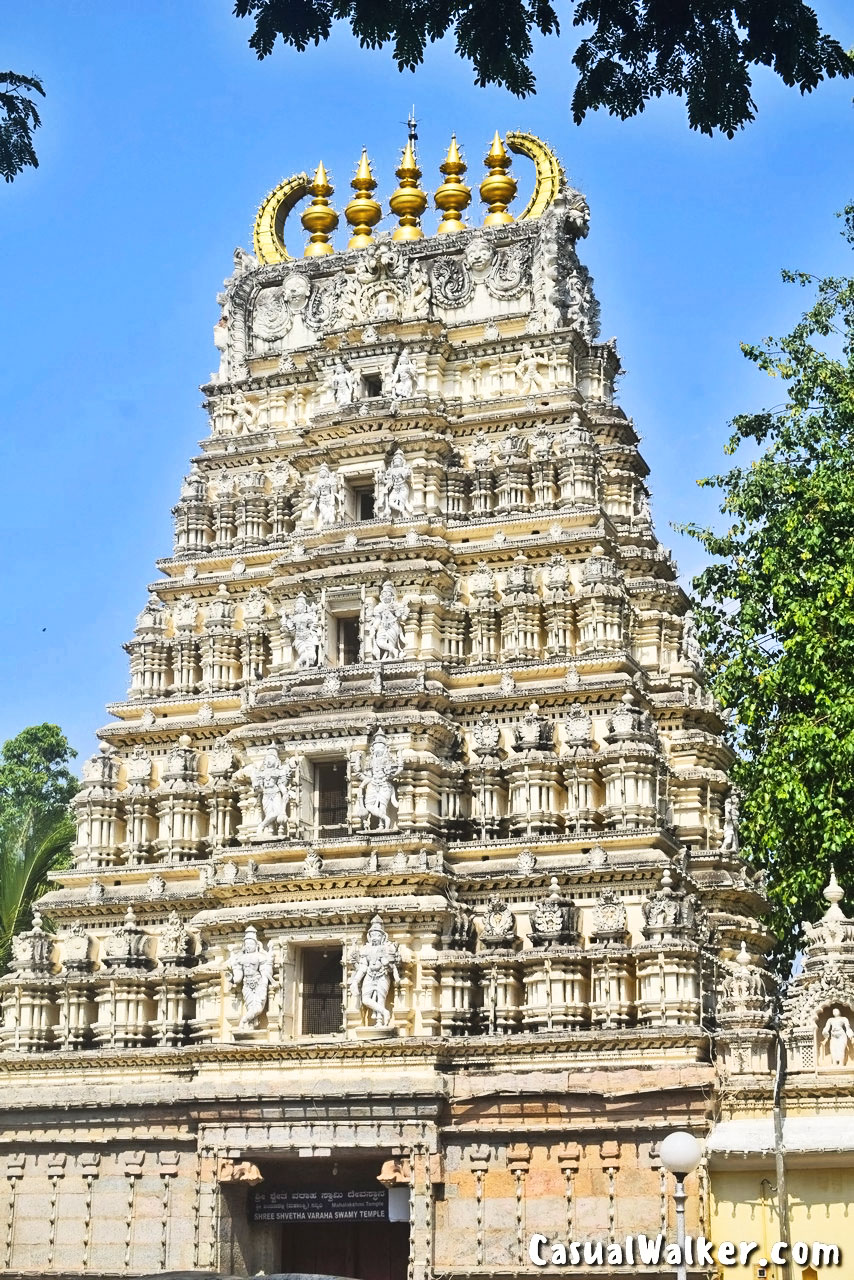
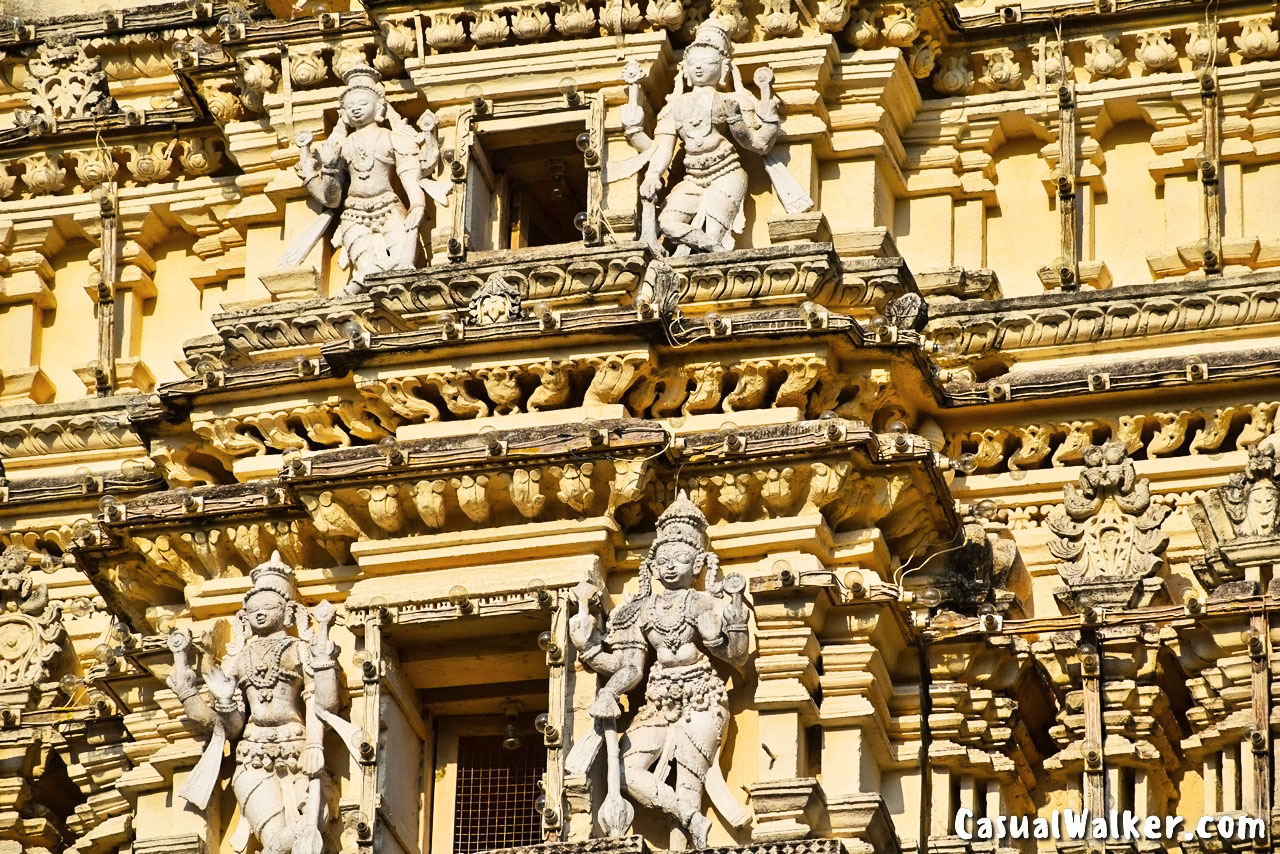
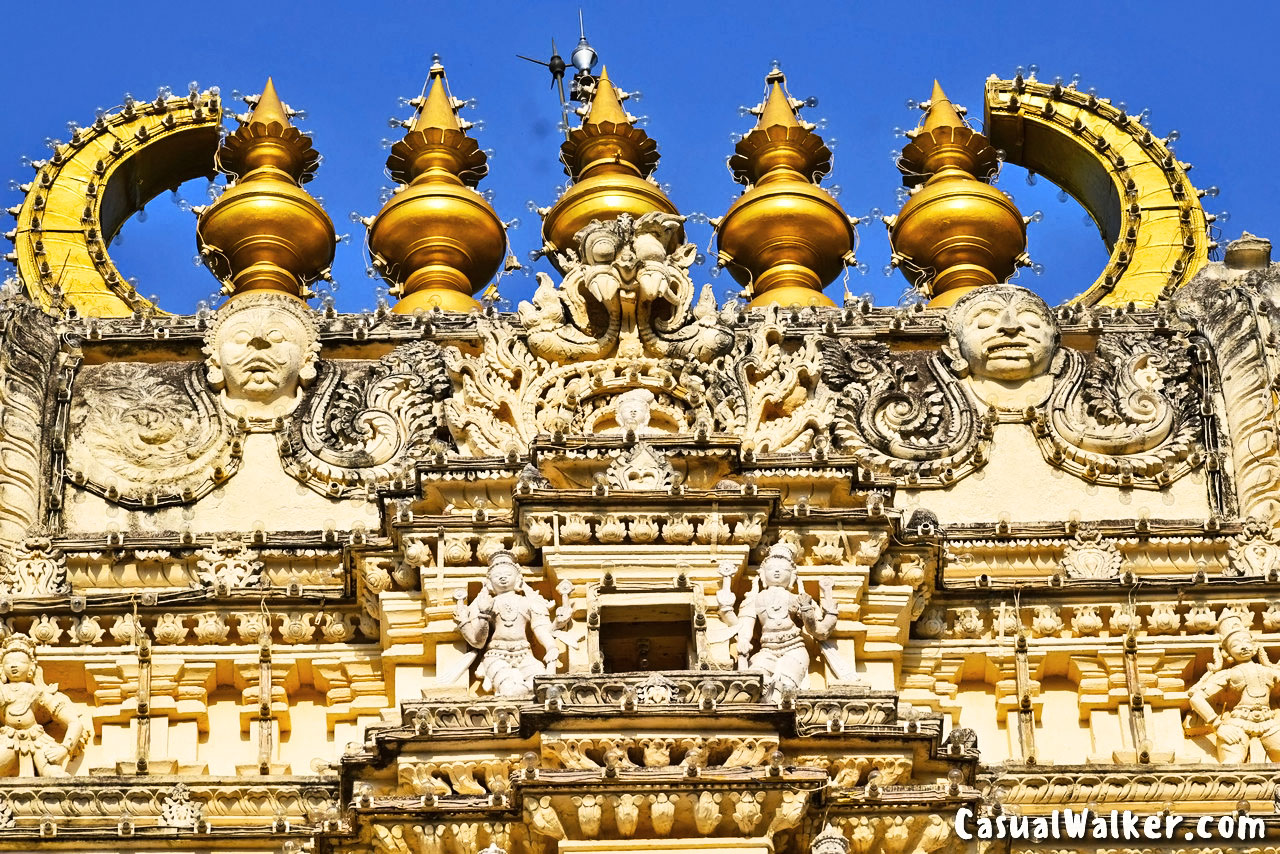
Travel Tips for Visiting Mysore Palace / Amba Vilas Palace in Mysore :
Mysore Palace / Amba Vilas Palace in Mysore Address:
Sayyaji Rao Rd, Agrahara, Chamrajpura, Mysuru, Karnataka 570001
Mysore Palace / Amba Vilas Palace in Mysore Timings: 10:00 am to 5:30 pm; every day
Mysore Palace / Amba Vilas Palace in Mysore Entry Fee: 100 INR for adults, 50 INR for kids above 10 years and below 18 years
Entrance to Palace for Tourists from three Gates: Varaha and Amba Vilas Gate at the South and Jayarama Balarama Gate at the North.
Photography without Flash is allowed
Mysore Palace / Amba Vilas Palace llumination timings: Sundays & Public Holidays: 7.00 pm – 8.00 pm.
Mysore Palace / Amba Vilas Palace Sound and Light Show: All days except Sundays & Govt. Holidays.
In Kannada Language Ticket Cost: Monday to Wednesday – Time 7.00 PM to 8.00 PM & Saturday – Time 8.15 PM to 9.15 PM – Entrance Ticket in Rs. Adults 100 and Children INR 40 / Ticket.
In English Language Ticket Cost: Thursday to Saturday – Time 7.00 PM to 8.00 PM – Entrance Ticket in Rs. Adults 120 and Children INR 50 / Ticket.
Ticket will be issued only at Varaha Gate Counter (South Side) from 6.30 pm onwards.
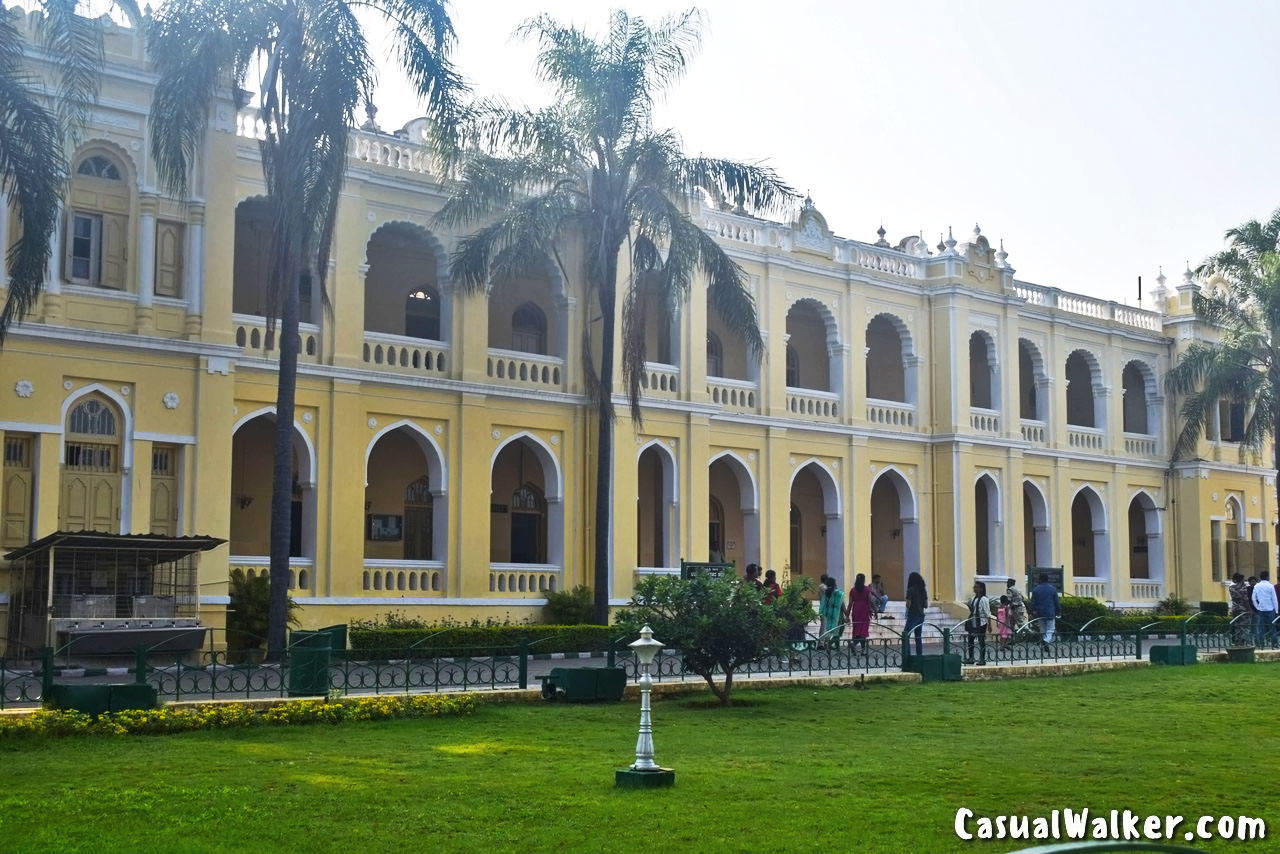
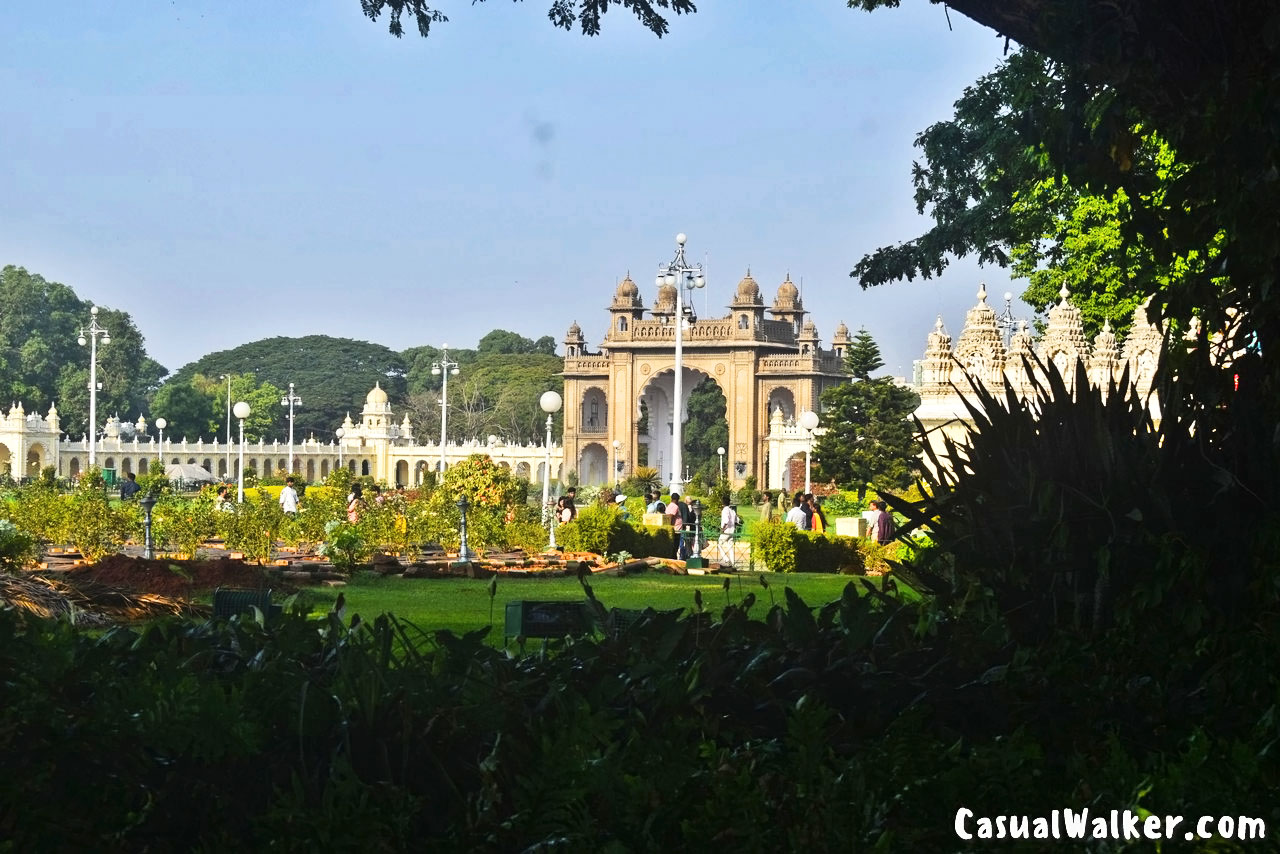
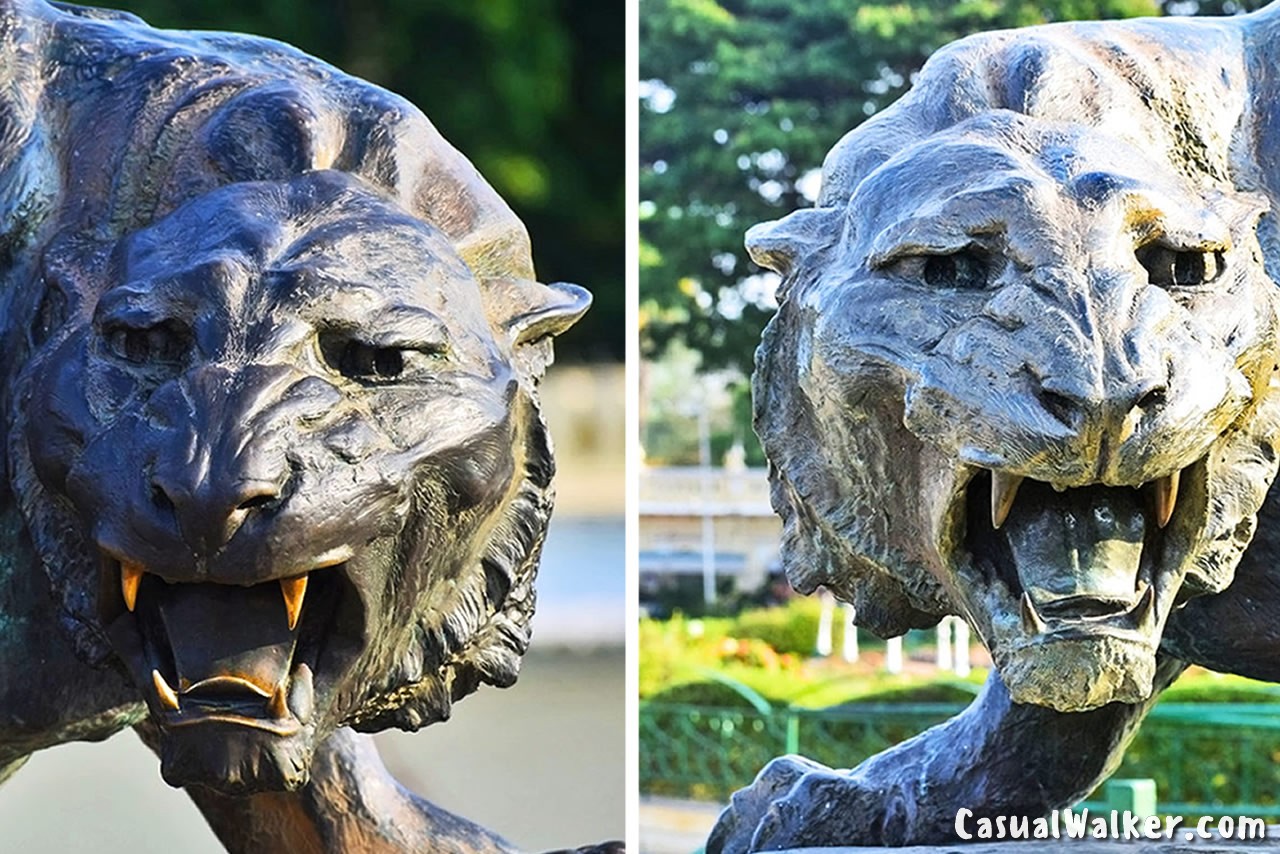
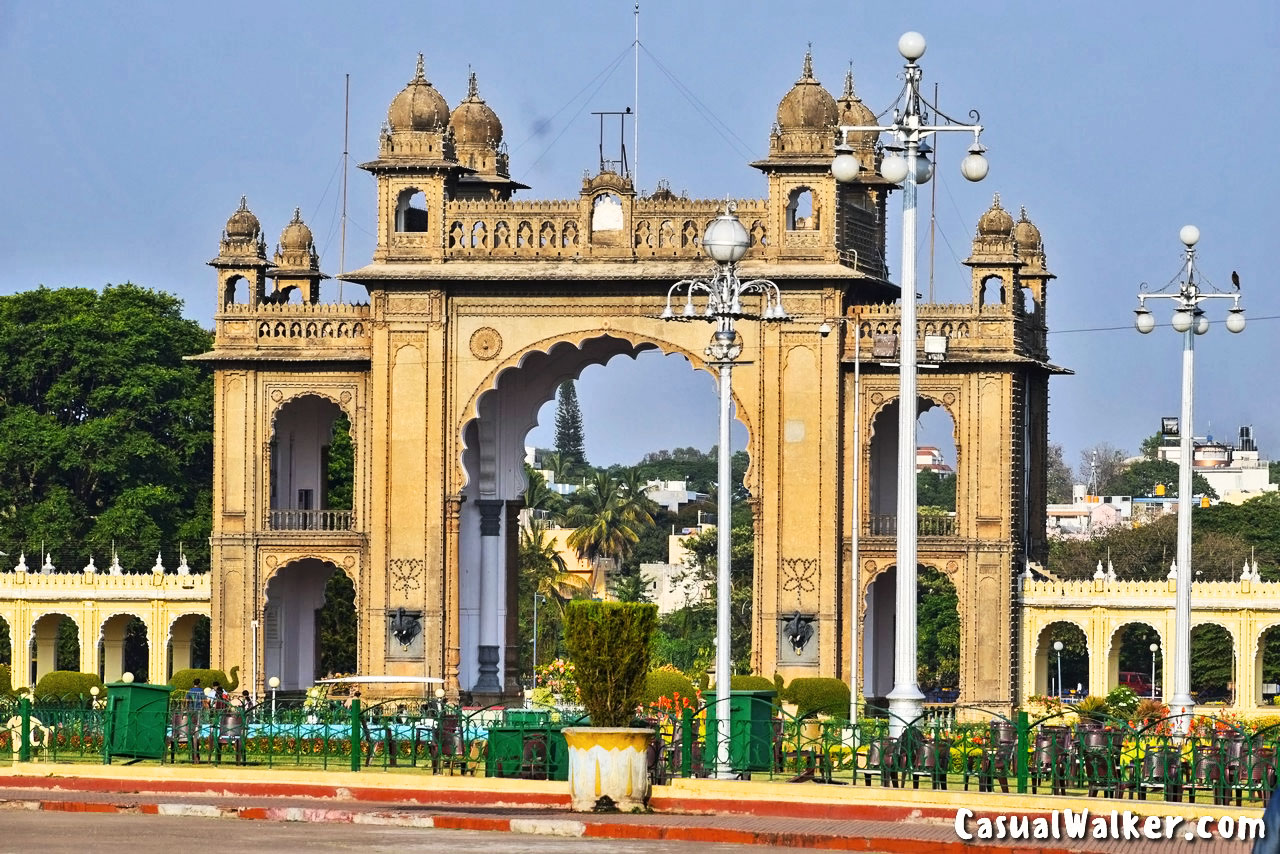
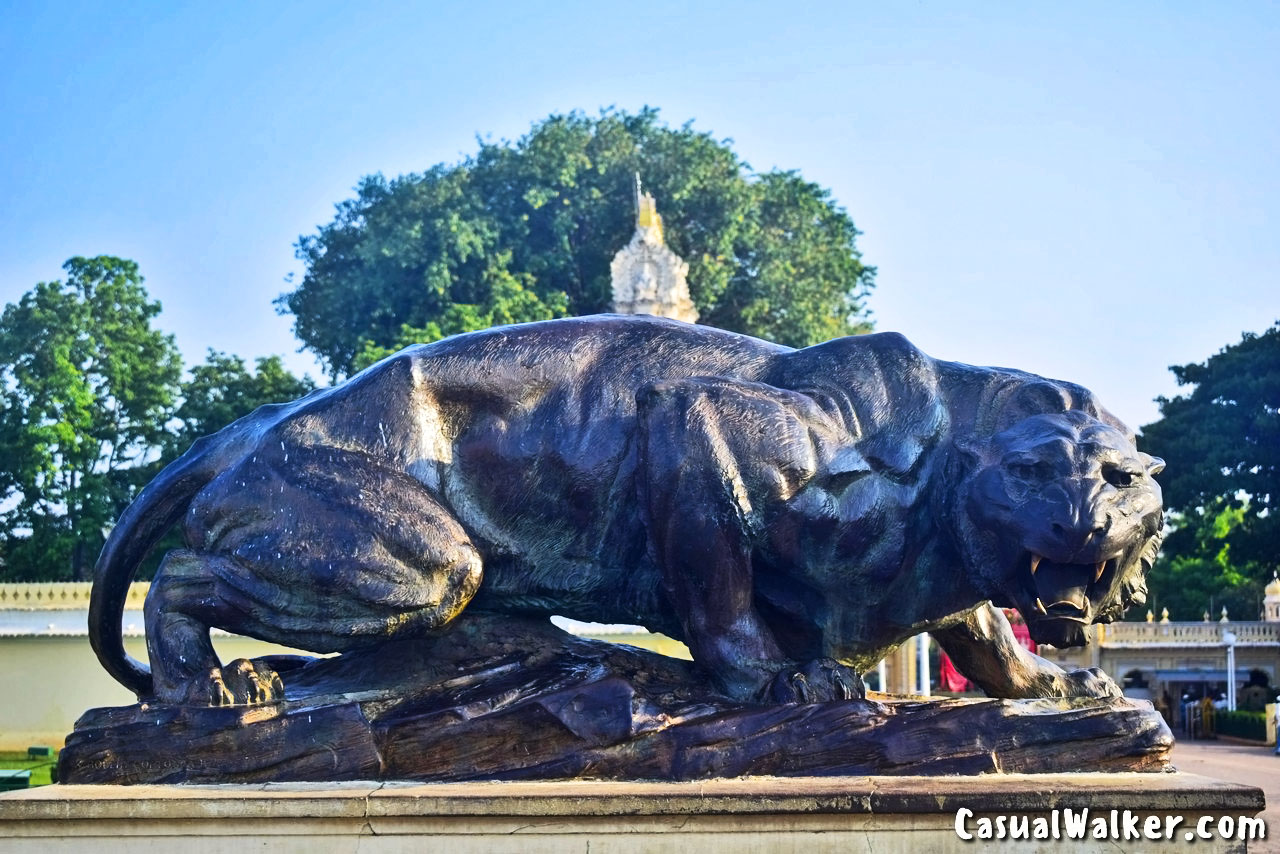
How to reach Mysore Palace / Amba Vilas Palace in Mysore
Located in the heart of Mysore city, visiting the palace is very easy.
By Road: You can get down at Mysore city bus stand and walk for 5 or 10 minutes to reach Mysore Palace. But passengers traveling by bus from out of town can take another local bus from the bus station for out-of-town buses to reach the palace which is a couple of kilometers away.
Nearest Railway Station: Mysuru Railway Station. From the Mysore railway station, the palace is a short distance away. However, there are plenty of buses going to the palace from the railway station. You can reach the palace from the railway station by bus or auto.
Nearest Airport: Mysuru is the nearest airport.
Also, check out our Similar Interesting Photo Stories
Chettinad Kanadukathan Palace and Attangudi / Athangudi Palace, Karaikudi Visit, Travel Guide
Asuras – Swarna Kolu / Golu, an Indian mythological Dolls & idols Exhibition at Thejus, Chennai
Also, Check out Our Similar Arts & Culture based Indian Museum :
Madras Literary Society library, Chennai – One of the Oldest library in India – Visit, Travel Guide
Cholamandal Artists’ Village, Museum Of Contemporary Art, Injambakkam, Chennai

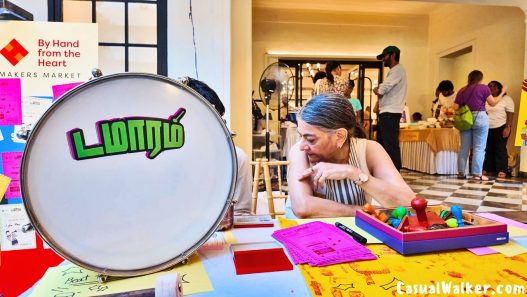

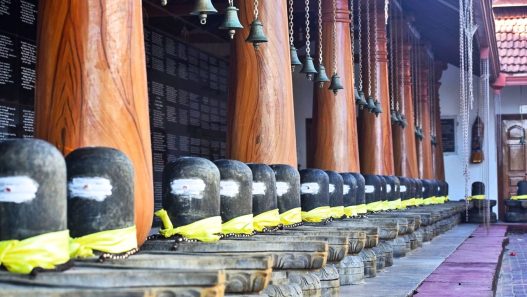

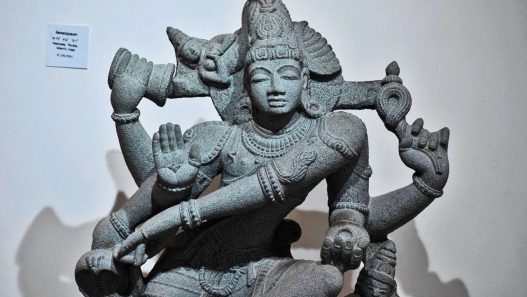

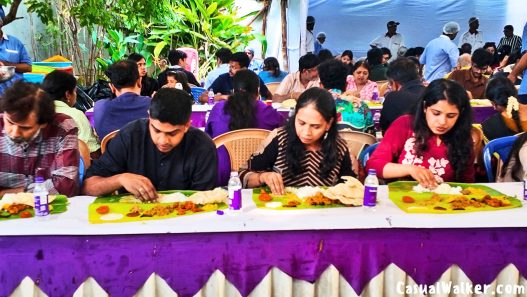
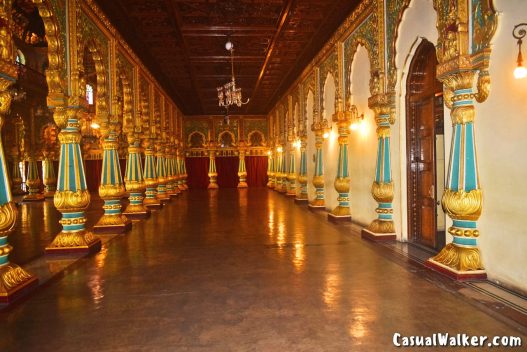

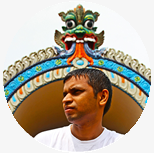


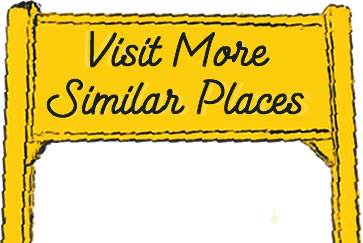

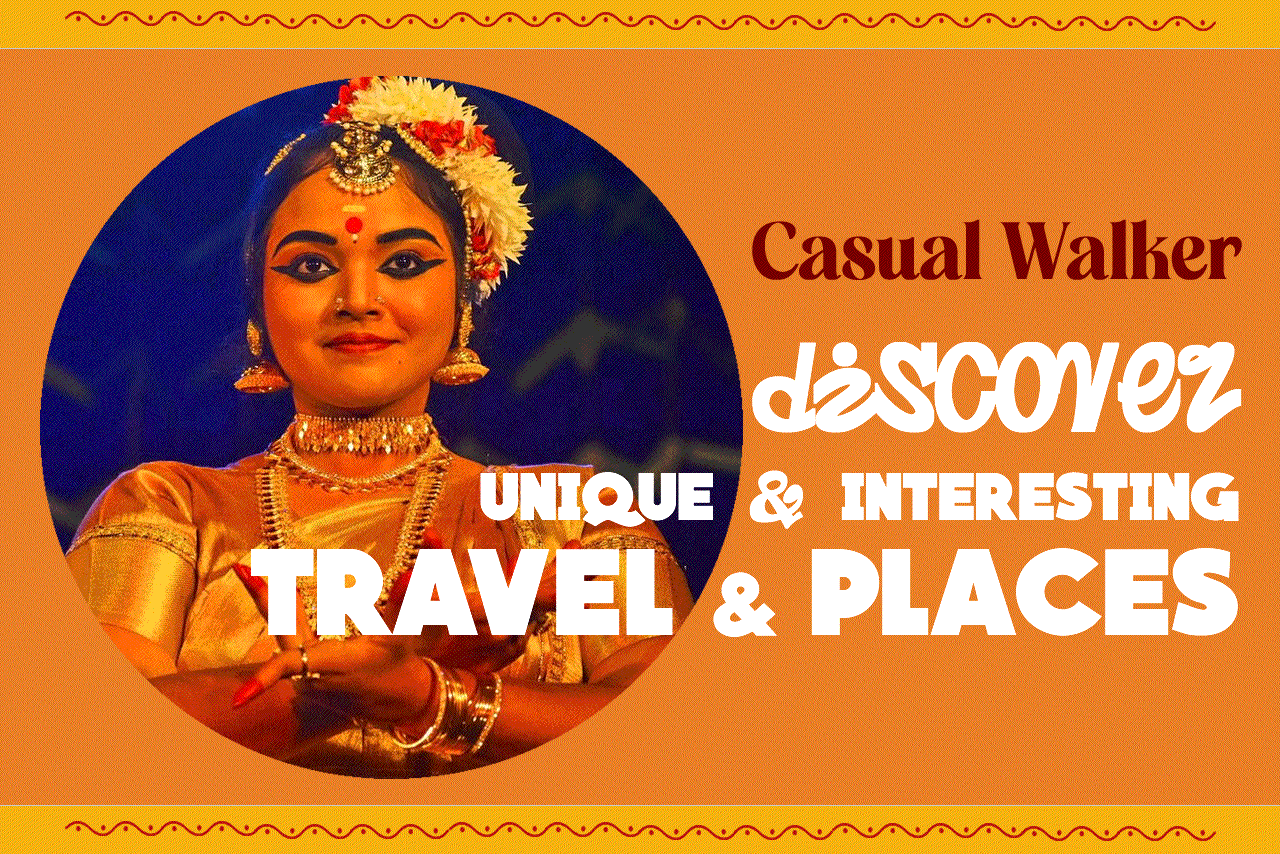











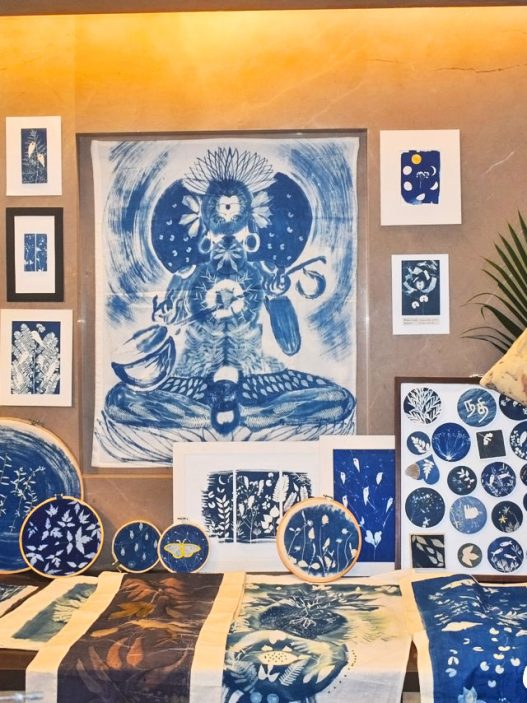
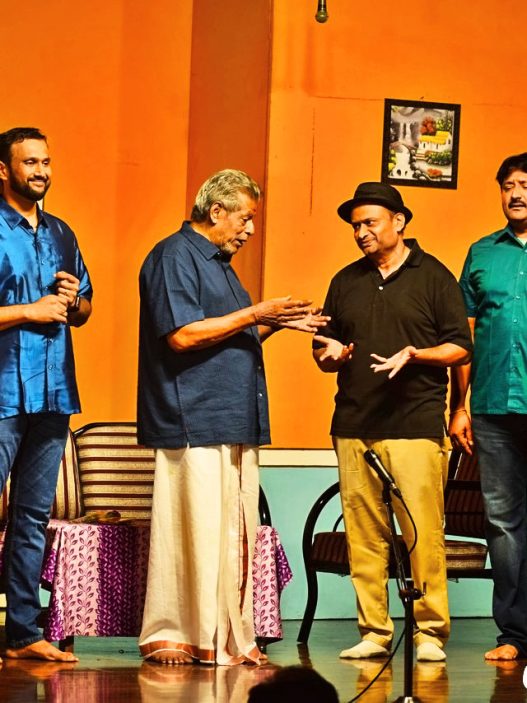
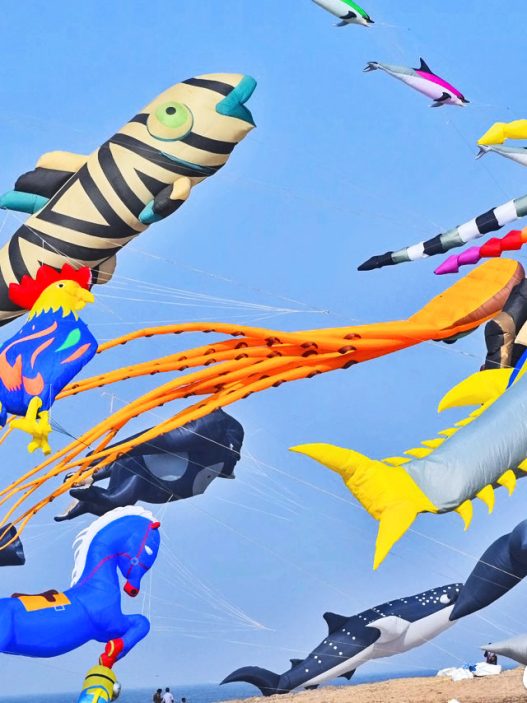
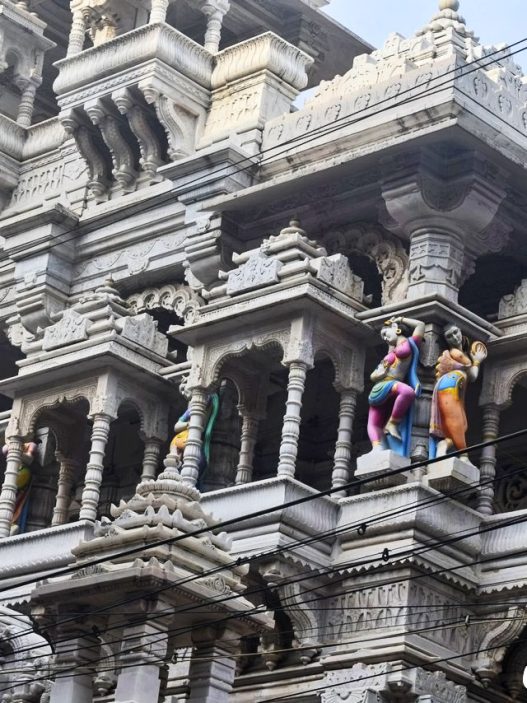
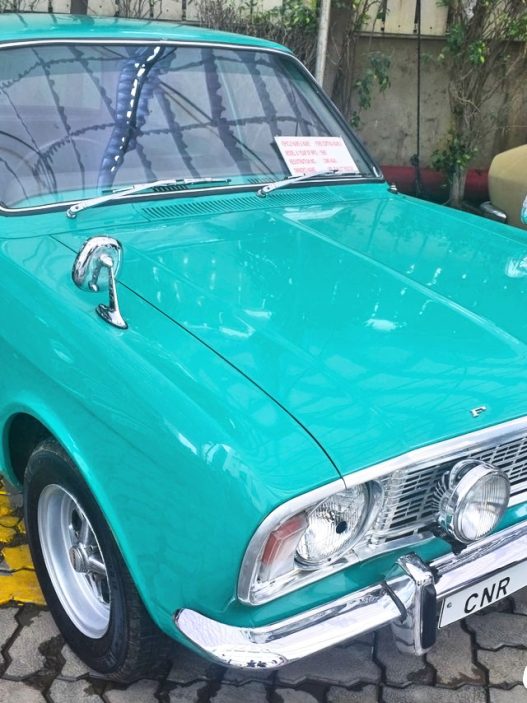
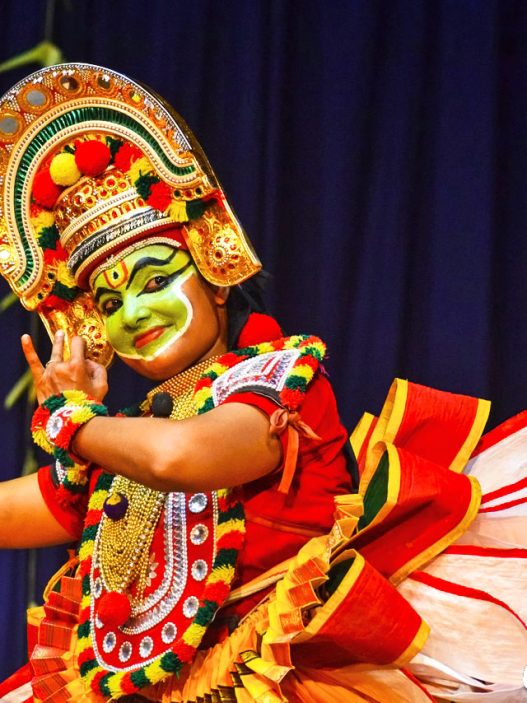
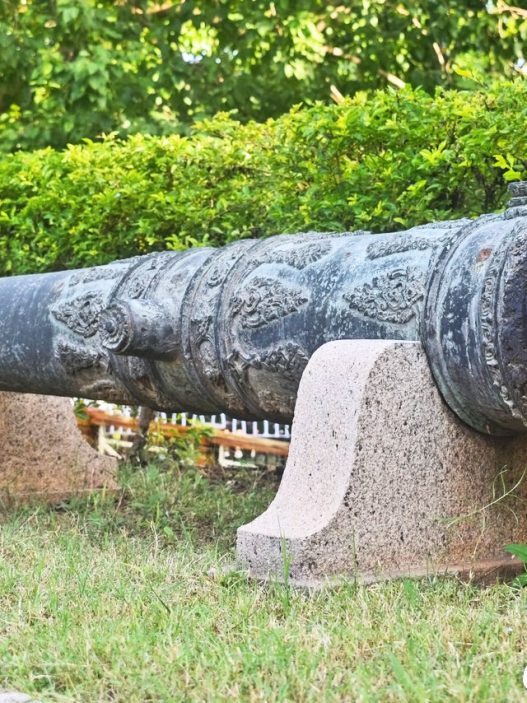
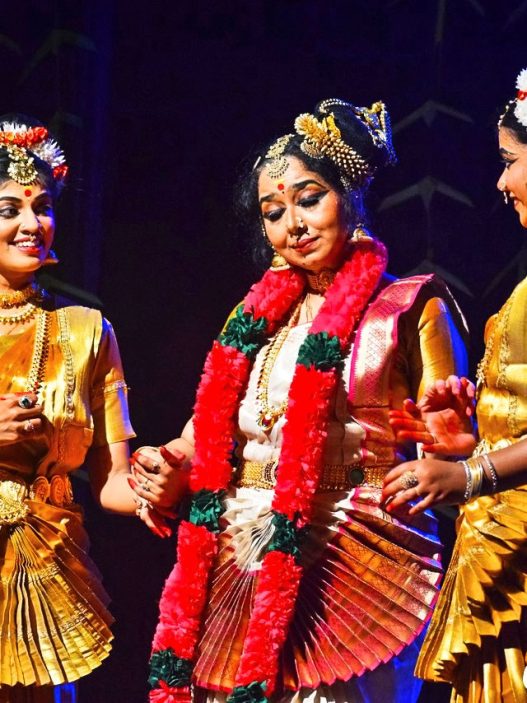
Rushbetbono, manito, es la onda para encontrar esos bonos que te dan un empujoncito extra. Échale un ojo y aprovecha las promos! Dale click aquí rushbetbono.
1861 vereinigten sich die italienischen Königreiche zu einem Land, dem Königreich Italien. Aber nach der Niederlage Napoleons wurde es unter die Obhut des italienischen Königreichs Sardinien gestellt.
Das Casino befindet sich in Monaco, einem Mikrostaat an der französischen Riviera, ganz in der Nähe der italienischen Region Ligurien. Obwohl sich
wohl kaum jemand die Entwicklung des ehrgeizigen Projekts vorstellen konnte.
Das Casino wurde geschaffen, um die finanziellen Schwierigkeiten der regierenden Familie Monacos, des Hauses Grimaldi, zu lindern. Um
die Bedeutung des Monte-Carlo Casinos zu verstehen,
müssen wir in der Zeit zurückgehen und etwas Kontext erhalten.
Anstatt nur eines Gebäudes, hatte Onassis jetzt die Kontrolle über die ganze
Gesellschaft mit dem Spielcasino und einigen Hotels. In dieser Situation besuchte der griechische Milliardär Aristoteles
Onassis 1952 Monaco. Nach dem Ende des Kriegs gingen die Geschäfte schlechter, die SBM
und damit auch das Spielcasino gerieten erneut in eine
finanzielle Schieflage. Während des Zweiten Weltkriegs standen die Räder im Spielcasino
niemals still. Zuvor und auch später hatten sich nizzaische Bürger und etliche Zeitungen aus moralischen Gründen immer gegen das Spielcasino ausgesprochen. Der Staatshaushalt Monacos wurde von da an für etliche
Jahrzehnte allein durch das Spielcasino gedeckt.
Der Hafen bietet als große, maritime Sehenswürdigkeit
Monacos Platz für bis zu 700 Boote. Während du am Hafen entlangflanierst, kannst du
auf die glänzenden Jachten und gigantischen Kreuzfahrtschiffe schauen. Nach dem Besuch des Ozeanographischen Museum ist
dein Smartphone weg? Und in der Sehenswürdigkeit in Monaco
wird sehenswerte zeitgenössische Kunst ausgestellt.
Spektakulär thront der Museumsbau am Hang des Felsens von Monaco-Ville über dem Mittelmeer.
References:
https://online-spielhallen.de/wunderino-casino-cashback-ihr-weg-zu-mehr-spielguthaben/
Welcome to the immersive universe of Royal Reels Casino, your one-stop destination for unrivaled online
gaming in Australia. Our streamlined sign-in page works flawlessly
on desktop, mobile, and tablet, so you can dive straight into the action whenever the urge
to play strikes. Experience premium casino gaming with Royal Reels 5 Australian favorite for sports betting and live casino action
Premier Australian casino with exclusive
pokies and generous bonuses Discover the ultimate gaming
hub for Australian players. The user-friendly interface, responsive customer support, and attractive bonuses
further enhance the overall appeal of the casino.
The live chat feature allows for instant communication with a support representative, providing real-time
solutions to player concerns. The availability of these diverse communication channels ensures that players
can have their questions resolved swiftly and efficiently, enhancing their overall
satisfaction with the casino’s services. Players can easily reach out to Royal Reels Casino through
multiple customer support options, including a comprehensive FAQ section that addresses common queries and concerns, ensuring a seamless
and efficient communication experience.
Shares in Star rallied on Monday, after the casino operator confirmed it had received bids to buy out
its stake in Brisbane’s Queen’s Wharf development, as it warned of “material uncertainty” about its future prospects.
The first day of the hearings has heard allegations leadership failed to address money laundering risks and criminal associations at
its casinos between 2017 and 2019. The Star Casino
and Hotel is dedicated to providing premium, personalized service, quality events and experiences,
and an array of first-class restaurants and accommodations.
It’s free to use, and racking up points and prizes is as easy as playing, dining and staying at one of the participating casinos, restaurants or hotels.
Another random day during the week the casino offers $1,000 five different times in the Cash Draw.
Room service, valet, and concierge are all ready to ensure that
your stay is in every way first-class.
Because the Star is located geographically in Sydney’s premium entertainment area,
it’s able to provide accommodations that are uniquely luxurious.
Rocking live bands, hilarious comedians, and engagingly unique musical acts are also on-hand.
The one thing that is missing from the facility is the chance to enjoy electronic gaming.
Whether you are a low stakes player or a high roller, you’ll find the table that’s just right for you at this casino.
References:
https://blackcoin.co/betman-casino-a-comprehensive-review-for-australian-gamblers/
casino with paypal
References:
jobsyt.com
paypal casino canada
References:
http://www.chinajobbox.com
Yo, 811betapp! Just tried it out. Not bad, pretty smooth! Definitely gonna be checking back in for more. Check it out yourself: 811betapp